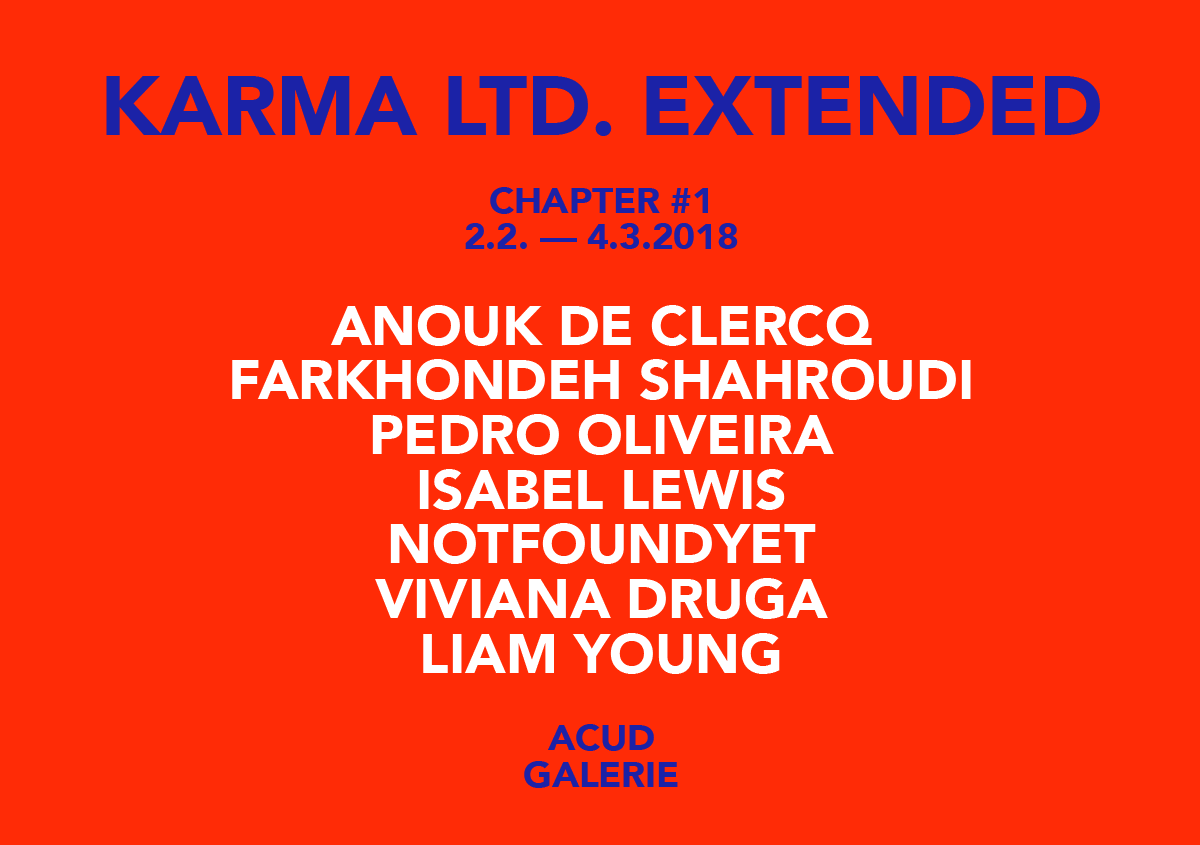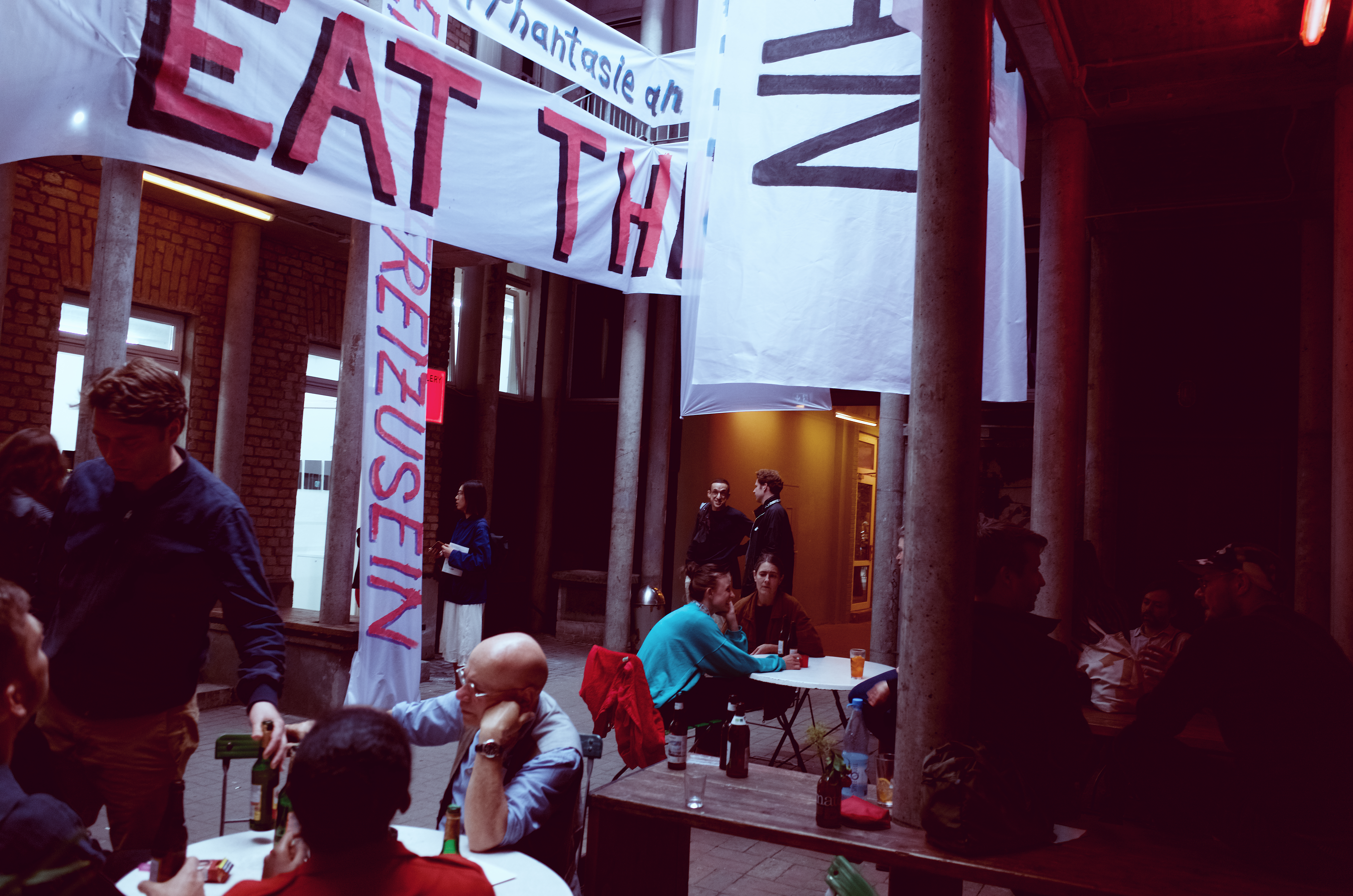
Karma Ltd. Extended is a curatorial collaboration between Pauline Doutreluingne, Petra Poelzl and Jana Haeckel that refers to the connections and effects of the digital transformation on the political, social, ecological and economic living conditions of the present. It puts the human imagination centerfold by focusing on artistic narratives about future possibilities of coexistence. In their research, the curators search for artistic trajectories and visions that broaden our senses for unexpected fantasies. They focus on the acting subject and design a wide variety of counter-perspectives and alternatives. Karma Ltd. Extended is political, poetic, performative, intersectional-feminist, experimental and much more.
Curated by Pauline Doutreluingne and Petra Poelzl (Karma Ltd. Extended)
Curatorial Assistant: Livia Tarsia In Curia
Press: Sabrina Kwiatkowski (sk | strategie & kommunikation)
Curatorial Intern: Hazal Kaygusuz, Diane Esnault
Exhibition Design: Torsten Oetken, Hazal Kaygusuz
Graphic Design: Julie Gayard
Logo Design: Norman Palm (Fertig Design)
CHAPTER #1: Imagination
CHAPTER #2: Transcultural Transience
CHAPTER #3: Variations on Time
CHAPTER #4: Post-Internet Mythologies
CHAPTER #5: Brauchen Wir einen Linken Populismus?
CHAPTER #6: Species of Spaces
CHAPTER #7: WORK WORK WORK oder Sie nennen es Arbeit

Farkhondeh Shahroudi, installation view in ACUD galerie
Courtesy the artist, ACUD gallery
Photocredit: Anneli von Klitzing

Farkhondeh Shahroudi, installation view in ACUD galerie
Courtesy the artist, ACUD gallery
Photocredit: Anneli von Klitzing

Farkhondeh Shahroudi, installation view in ACUD galerie
Courtesy the artist, ACUD gallery
Photocredit: Anneli von Klitzing

Farkhondeh Shahroudi, installation view in ACUD galerie
Courtesy the artist, ACUD gallery
Photocredit: Anneli von Klitzing

Anouk De Clercq installation view, "Thing" (video, b/w, 16:9, stereo, BE/IT/FR, 2013, 17min)
Courtesy the artist, ACUD gallery
Photocredit: Anneli von Klitzing

Anouk De Clercq installation view, "Thing" (video, b/w, 16:9, stereo, BE/IT/FR, 2013, 17min)
Courtesy the artist, ACUD gallery
Photocredit: Anneli von Klitzing
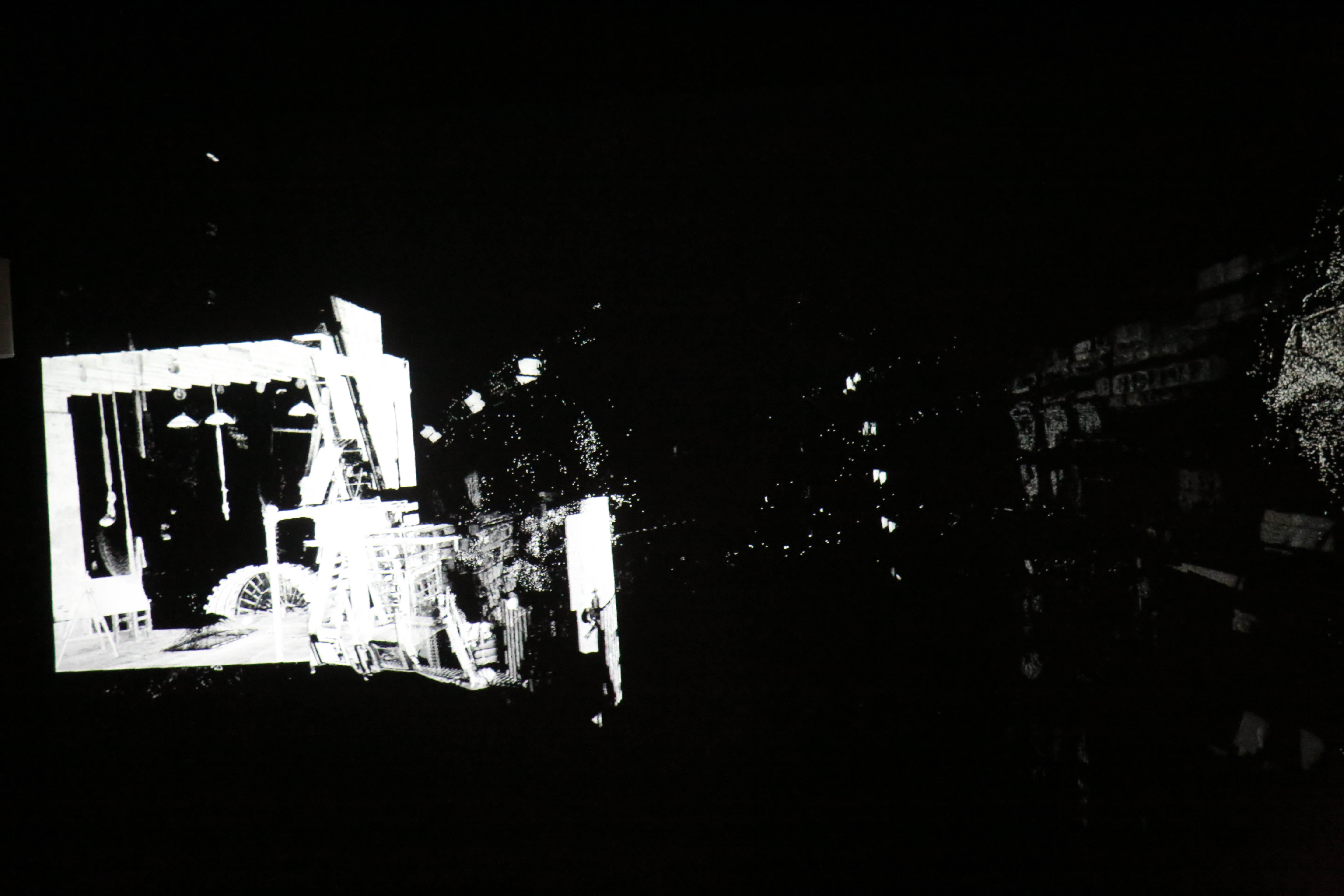
Anouk De Clercq installation view, "Thing" (video, b/w, 16:9, stereo, BE/IT/FR, 2013, 17min)
Courtesy the artist, ACUD gallery
Photocredit: Anneli von Klitzing

Viviana Druga's installation, Hay Monster, * Bring your Prayers *, courtesy of the artist. Photo: Anneli von Klitzing

Karma She live performance

Karma She live performance

Notfoundyet, "Studiovisit"

arkhondeh Shahroudi, installation view in ACUD galerie
Courtesy the artist, ACUD gallery
Photocredit: Anneli von Klitzing

Isabel Lewis, Occassions, live performance

Isabel Lewis, Occassions

Liam Young: City Everywhere
March 3, 2018
Photocredit: Tobias Konig — at ACUD MACHT NEU.

Liam Young: City Everywhere
March 3, 2018
Photocredit: Tobias Konig — at ACUD MACHT NEU.
KARMA LTD. EXTENDED
CHAPTER #1: IMAGINATION
02.02. – 04.03.2018
Anouck De Clercq (Ghent/Berlin), Farkhondeh Shahroudi (Téheran/Berlin), Pedro J S Vieira de Oliveira (Brazil/Berlin), Isabel Lewis (New York/Berlin), Notfoundyet (Vienna), Viviana Druga (Transylvania/Berlin), Karma She (Israel/Berlin) and Liam Young (London/Australia)
Humans and their innovations are in constant evolution. The stories we imagine carve future developments. The futuristic visions in the science fiction films from the past did indeed manifest. Technologies merge with our genes and the arrival of more advanced and intelligent beings is expected. While many classic tales might be seen as superstitious or surreal to our present-day selves, these so called “tales” were as real as our current set of ideologies, may it be religion, miracles, cyborgs, aliens, nations, and beliefs such like “free democracies”. Storytelling and imagination remain a crucial drive for the future of our society. Stories that have been passed on time and time again have evolved into the mortar that bonds cultures. These stories build a collective body of belief systems, customs, stereotypes, values and codes. Changes in the social and political fabric inspire new narratives drawn in the collective mind. From the beginning of belief systems, from Hinduism to Plato, it has been suggested that the world is an imaginary world of illusion, and some argue that the modern human already lives in an imaginary world or simulation.
In an age, where political and social imagination runs dry, the presented works in the exhibition Karma Ltd. Extended, puts the human gift of imagination in its centerfold, looking at alternative narratives about being in the now and near future of possibility. This exhibition delves into the work of selected artists who through the media of film, sculpture, sound, text and performance, mould new imaginations and invite viewers minds to travel to unseen destinations.
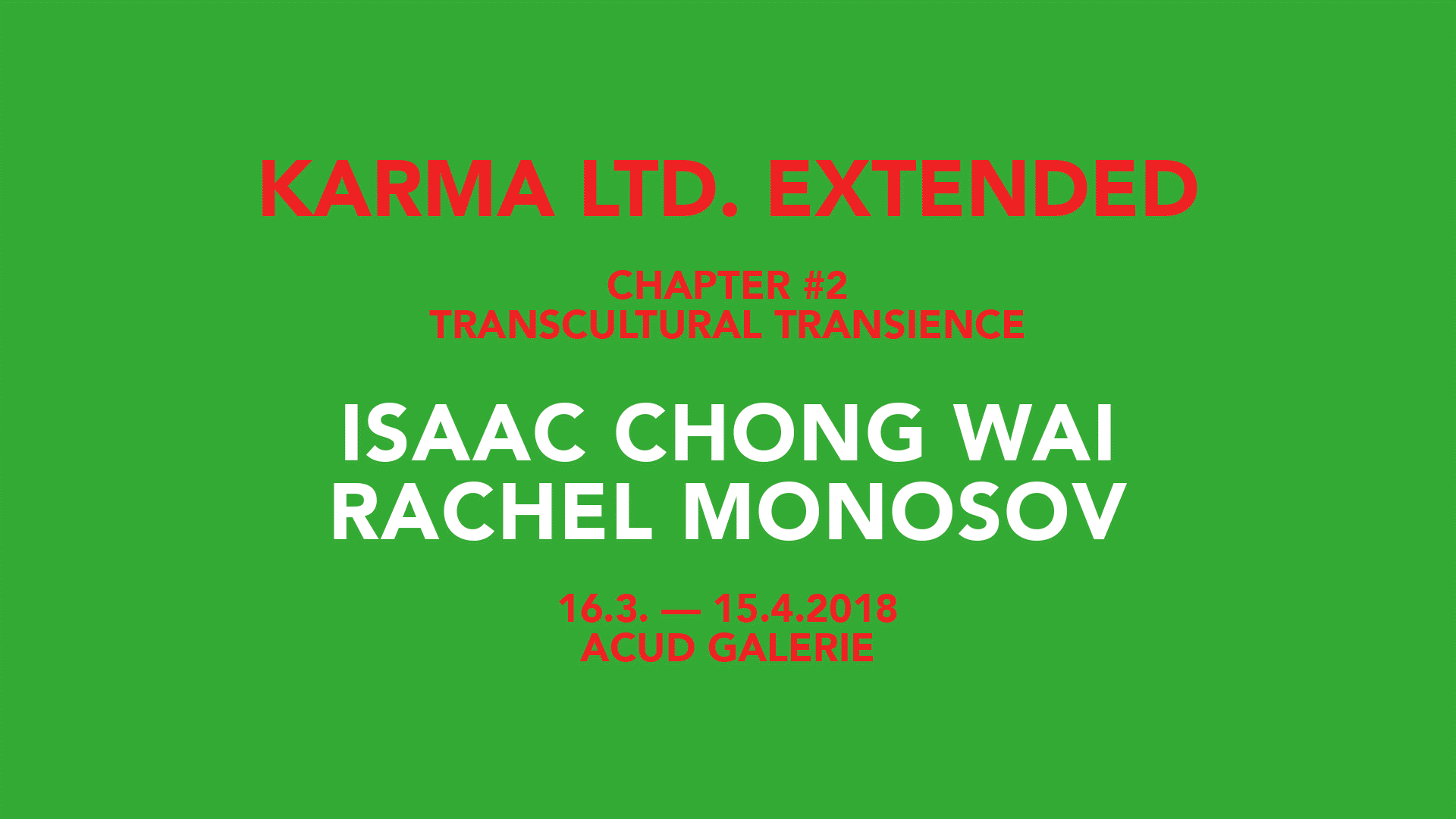
KARMA LTD. EXTENDED
CHAPTER #2: TRANSCULTURAL TRANSIENCE
16.03. – 15.04.2018
We cannot act without supports, and yet we must struggle for the supports that allow us to act. (Judith Butler in: Notes Toward a Performative Theory of Assembly)
Transcultural Transience, the second chapter of the curatorial collaboration Karma Ltd. Extended, is approaching political aspects of history, while investigating notions of ephemerality, knowledge-production, and transmission. During five weekends, the gallery hosts a site-specific and process-oriented performance series, a lecture, and a screening program.
The newly commissioned durational works by Isaac Chong Wai and Rachel Monosov question how embodied collective memory can be reconsidered and dealt with through performance. By looking at large-scale gatherings, such as demonstrations and the Olympic Games, the artists are investigating the role of the individual within those assemblages. What is the function of the bystander, who unexpectedly becomes part of a public demonstration? And what can we make of human bodies, marked by weakness and perfection, which become symbols for a national or political struggle? These are examples of questions that arise, more frequently so within our societies becoming rapidly digital— as human activity becomes increasingly virtual, and the line between physical and virtual spaces our bodies inhabit become blurred.
This performance series took its beginning from politically charged images that surround and accompany the immediateness of our online personalities every day. These images are a trace of a political past, which continue reiterating themselves into the future. What if we try to slow down the speed of distribution of images on the world wide web? How can we understand, translate, capture, edit, and seek to archive these images that flicker on our screens? And yet they slip away in the invisible archives of the multinational corporations and we, once again turn into passive bystanders within a large-scale global process. Being connected to the Internet is simultaneously a transience and transcultural act, as one can momentarily extend political borders and spaces.hat if we try to leave those virtual ephemeral platforms and assemblies behind and start to perform again outside of the laptop screen?
Slavs and Tatars are aiming for a visualization of transcultural transience in the history of the human being. They refer to themselves as archaeologists of the everyday as they draw upon deeper layers of meaning exemplified by tradition, custom, performance, language, anthropology and politics. By breathing life back into vast, misunderstood and often forgotten regions, the artist collective aims to resuscitate Eurasia.
Abrie Fourie, a Berlin-based photographer and artist from South-Africa, shares his knowledge and perspective on documented performance works by South African artists and the diaspora. His curated film series MINE – The Film Will Always Be You offers a rare and in depth look on performance ephemerality captured on film, which seeks to explore the myriad ways in which we identify and position ourselves.

The Rehearsal of the Futures: Is the World your Friend? by Isaac Chong Wai, Photo: Tobias Koenig

The Rehearsal of the Futures: Is the World your Friend? by Isaac Chong Wai, Photo: Tobias Koenig

The Rehearsal of the Futures: Is the World your Friend? by Isaac Chong Wai, Photo: Tobias Koenig

The Rehearsal of the Futures: Is the World your Friend? by Isaac Chong Wai, Photo: Tobias Koenig

The Rehearsal of the Futures: Is the World your Friend? by Isaac Chong Wai, Photo: Tobias Koenig
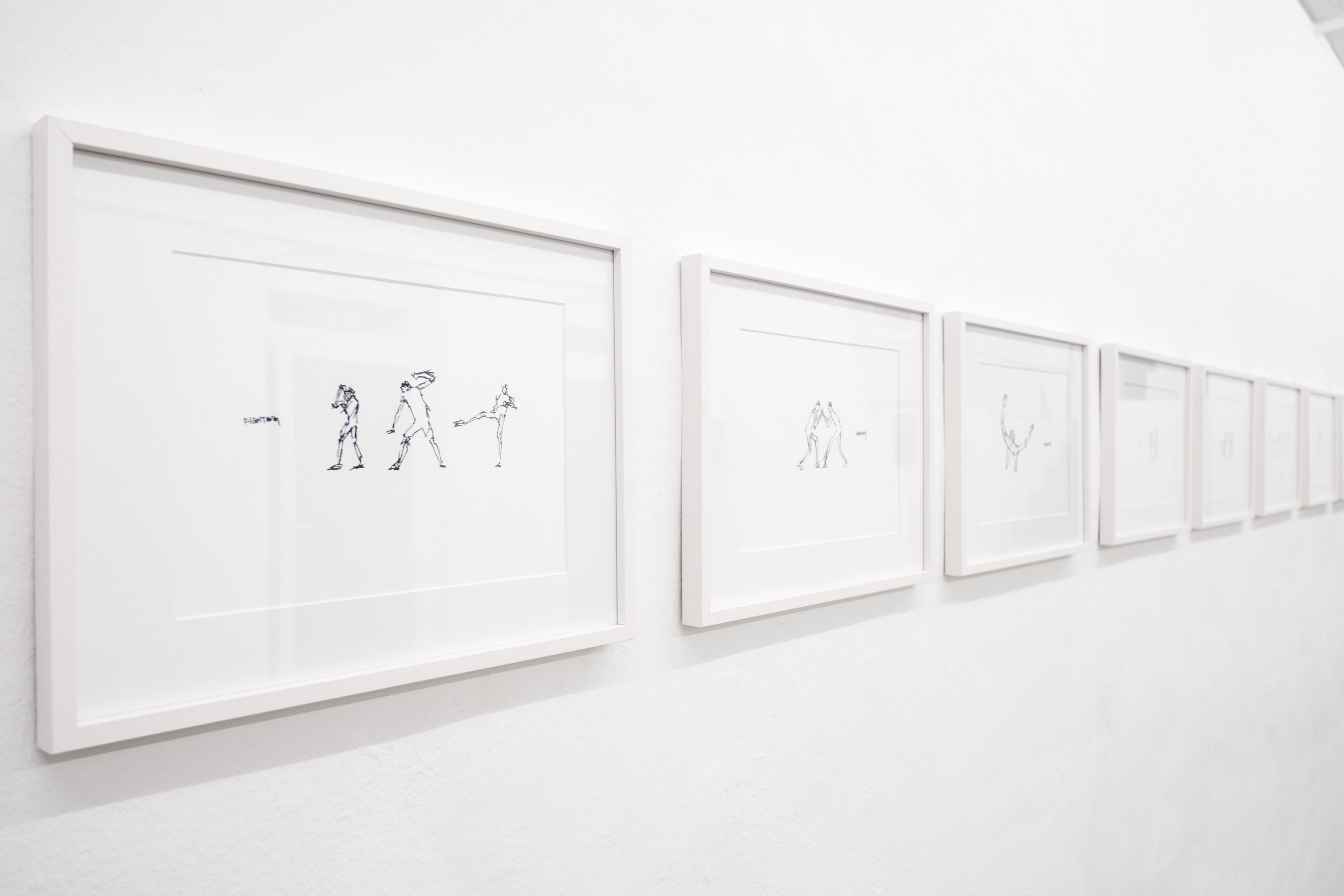
The Rehearsal of the Futures: Is the World your Friend? by Isaac Chong Wai, Photo: Tobias Koenig

ACUD Kunsthaus Photo: Tobias Koenig

Black Cracker Live Photo: Tobias Koenig

Black Cracker Live Photo: Tobias Koenig

Black Cracker Live Photo: Tobias Koenig

OLYMPIA by Rachel Monosov. Photocredit: Anneli von Klitzing

OLYMPIA by Rachel Monosov with dancer Rachell Bo Clark

OLYMPIA by Rachel Monosov. DANCERS: Victor Dumont, Susie Yugler, Rachell Bo Clark, Stepanie Amurao, Katrina Elizabeth Photocredit: Anneli von Klitzing

OLYMPIA by Rachel Monosov. DANCERS: Victor Dumont, Susie Yugler, Rachell Bo Clark, Stepanie Amurao, Katrina Elizabeth Photocredit: Anneli von Klitzing

Scene from OLYMPIA by Rachel Monosov
Photo Credit: Anneli von Klitzing — with Susie Yugler, Katrina Elizabeth and Steph Amurao at ACUD Galerie.

OLYMPIA by Rachel Monosov. DANCERS: Victor Dumont, Susie Yugler, Rachell Bo Clark, Stepanie Amurao, Katrina Elizabeth Photocredit: Anneli von Klitzing

OLYMPIA by Rachel Monosov. DANCERS: Victor Dumont, Susie Yugler, Rachell Bo Clark, Stepanie Amurao, Katrina Elizabeth MUSIC: INRA (Philipp Rhensius & Adam Ben Nun) LIVE VISUALS: Lisa Lapierre PHOTO CREDIT: Anneli von Klitzing

OLYMPIA by Rachel Monosov. DANCERS: Victor Dumont, Susie Yugler, Rachell Bo Clark, Stepanie Amurao, Katrina Elizabeth MUSIC: INRA (Philipp Rhensius & Adam Ben Nun) Live Visuals: Lisa Lapierre Photocredit: Anneli von Klitzing
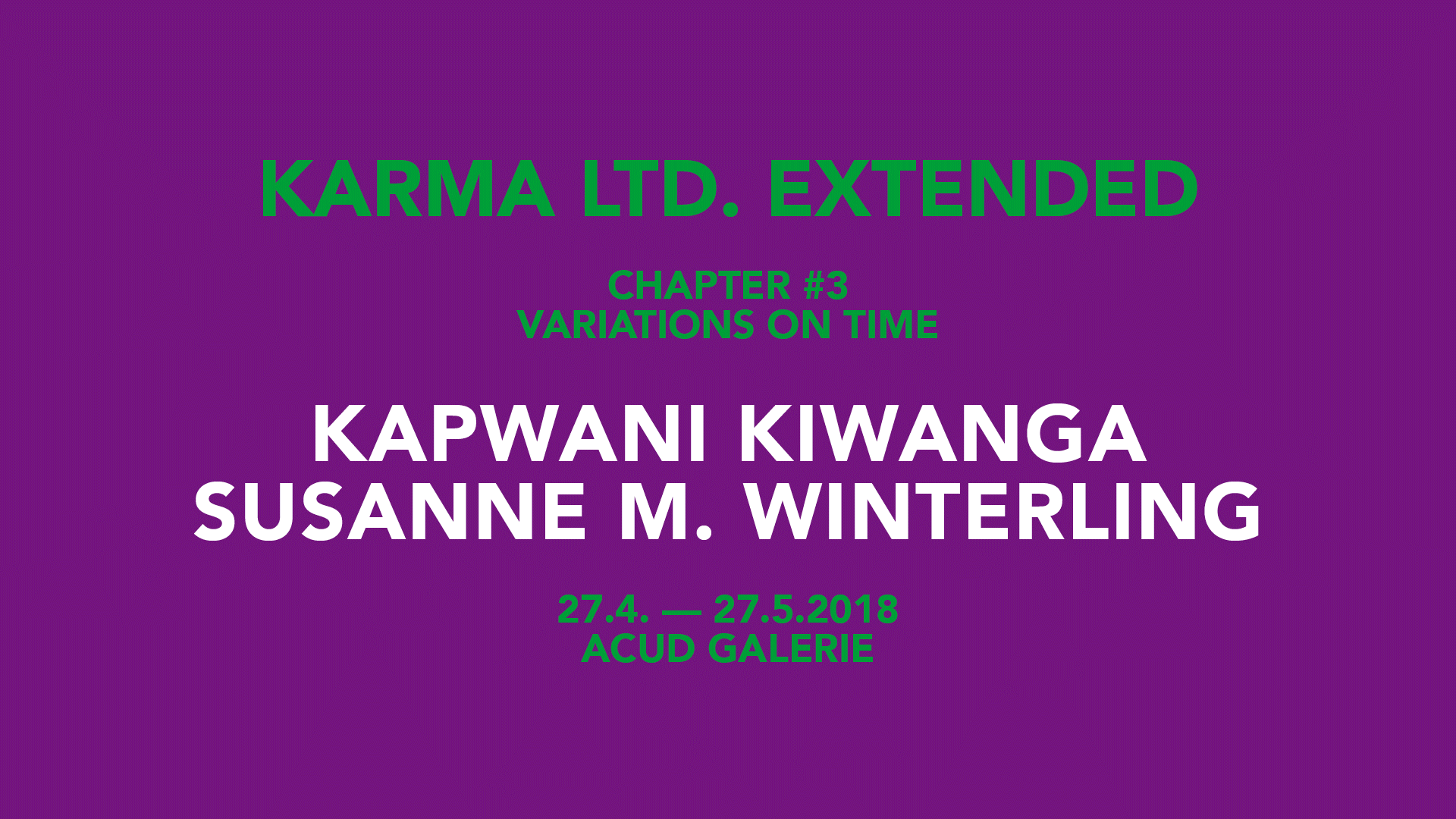
KARMA LTD. EXTENDED
CHAPTER #3: VARIATIONS ON TIME
27.04. – 27.05.2018
There is neither source nor end, for all things are in the Center of Time. As all the stars may be reflected in a round raindrop falling in the night: so too do all the stars reflect the raindrop. There is neither darkness nor death, for all things are, in the Light of the Moment, and their end and their beginning are one.
― Ursula K. Le Guin, The Left Hand of Darkness
In the third chapter Variations on Time, Karma Ltd. Extended presents the work of three female artists who deal with non-anthropocentric, organic tenses and question traditional time patterns. By providing access to forms of knowledge and understandings that are suppressed by dominant linear and anthropocentric time culture, they invite us to imagine different ways of interspecies co-existence and counter-narratives.
The dominant model of time in contemporary Western societies is known as a linear, goal-oriented time: a ‘mechanical’ time that can be measured, owned, used, bought and sold by humans.
Thinkers such as the geologist James Hutton, who put forward the theory on Deep Time in the 18th century, assumed that the age of the Earth has been determined to around 4.55 billion years. According to this geological timeline, humans have been around for an extremely short period.
By zooming out from micro to macro, it becomes clear that the timeframe of the Anthropocene is relatively short in time. This is visible through a number of examples such as the oral storytelling tradition of indigenous peoples in Australia. Through these stories, one is told that dramatic sea level rises across Australia date back more than 7,000 years. Several researchers claim that these indigenous stories from across the continent recorded events between 18,000 and 7000 years ago, when the sea rose 120m.
If one looks at the adaptation and survival skills of plants and other organisms, and look at time through their perspective, one can learn and foresee possibilities for future scenarios.
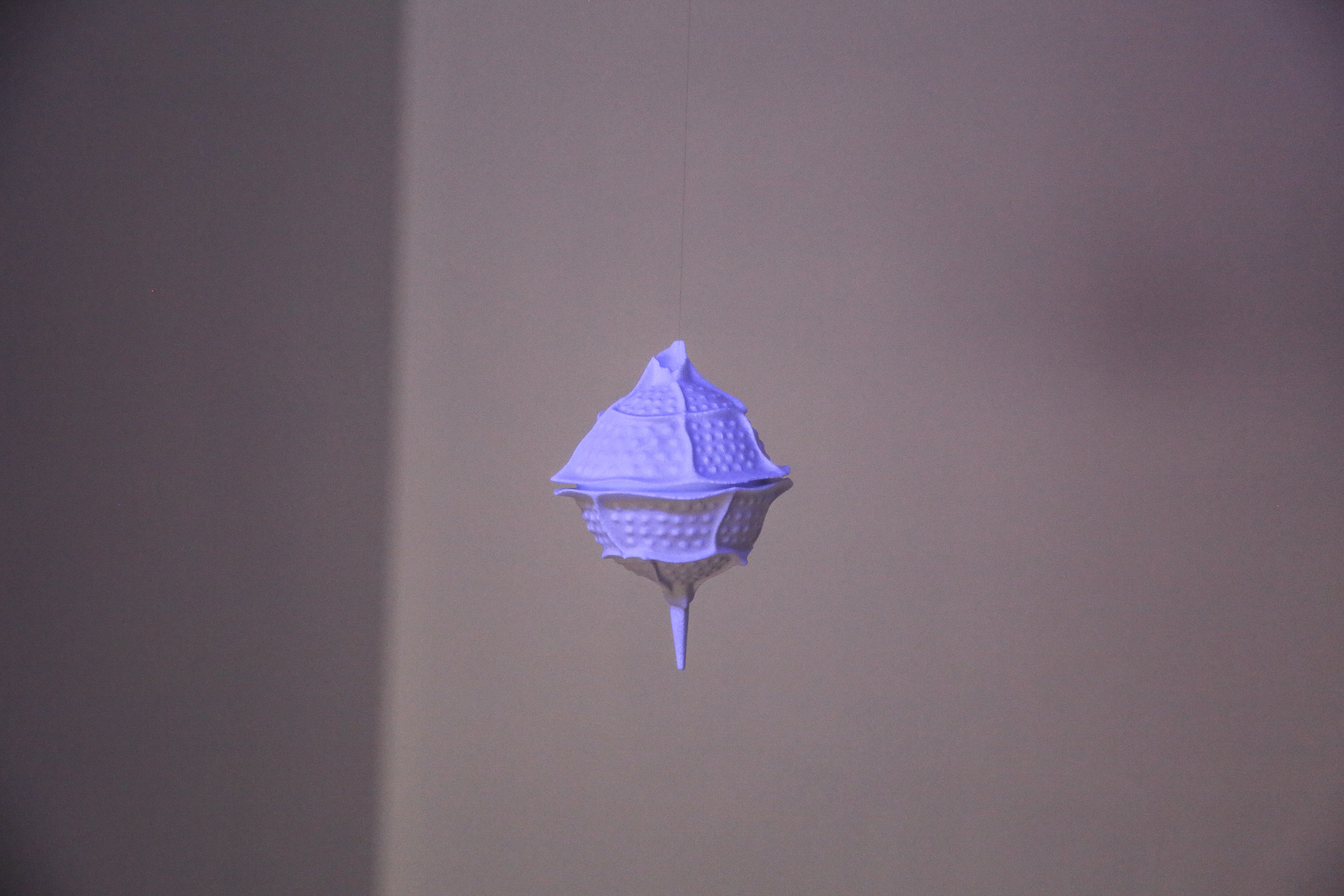
Vertex Immersion Metabolic by Susanne M. Winterling
2015, mixed media 3d print UV light
courtesy the artist
Photo by Anneli von Klitzing

Untitled (Carpet ecocide Bombay beach) by Susanne M. Winterling
2017
Photo by Anneli von Klitzing

"Epiphyte (to learn from)"
Susanne Winterling
2018
Photo by: Anneli von Klitzing
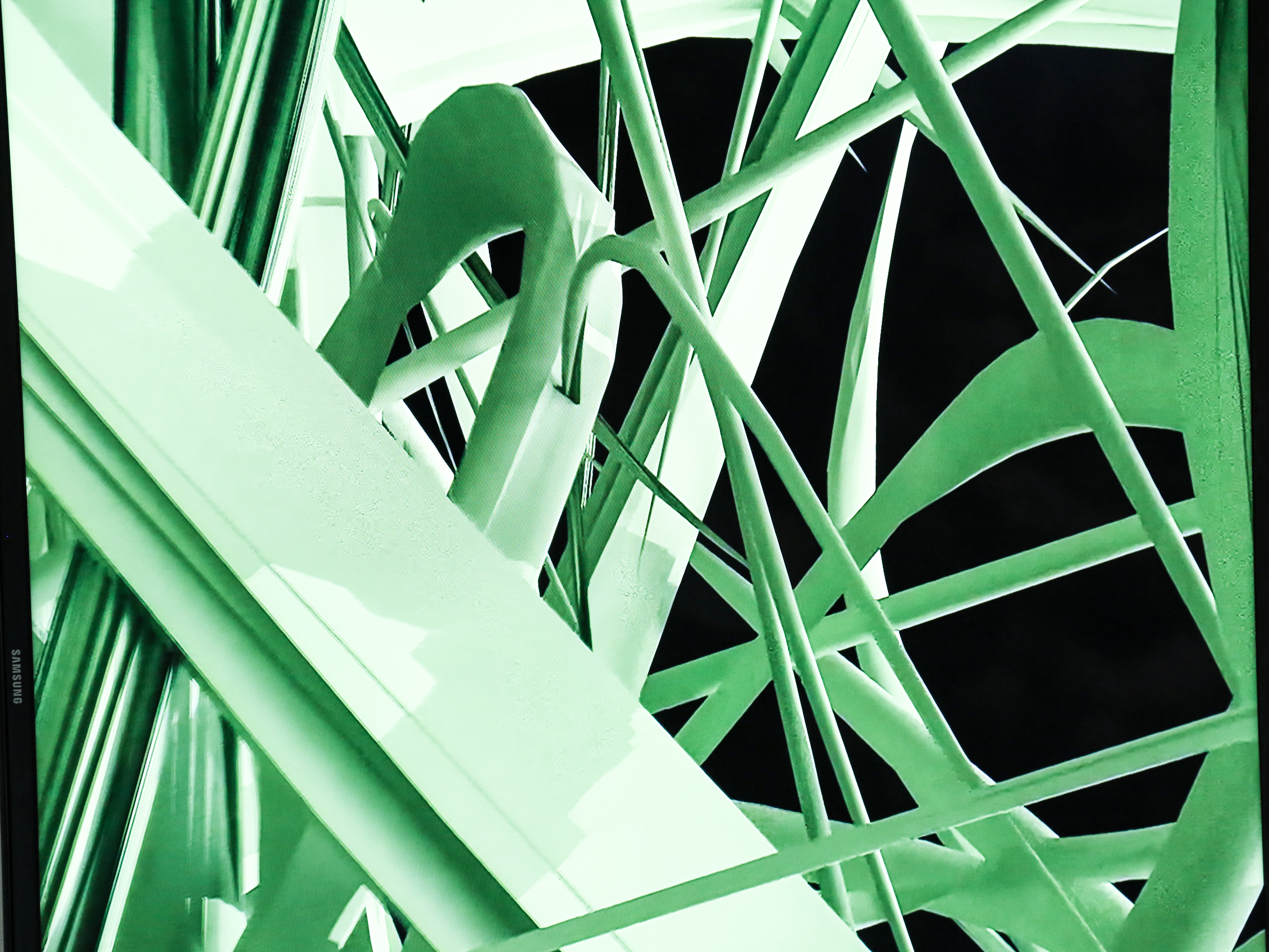
"Epiphyte (to learn from)"
Susanne Winterling
2018
Photo by: Anneli von Klitzing

Vertex Immersion Metabolic
by Susanne M. Winterling
2015, mixed media 3D print, UV light
courtesy the artist
Photo by Anneli von Klitzing

Detail of "untitled (carpet ecocide bombay beach)"
2017, Susanne M. Winterling
Photo by Anneli von Klitzing

"Subduction Studies"
Kapwani Kiwanga
2015-2017
Photo by Anneli von Klitzing

"Subduction Studies"
Kapwani Kiwanga
2015-2017
Photo by Anneli von Klitzing
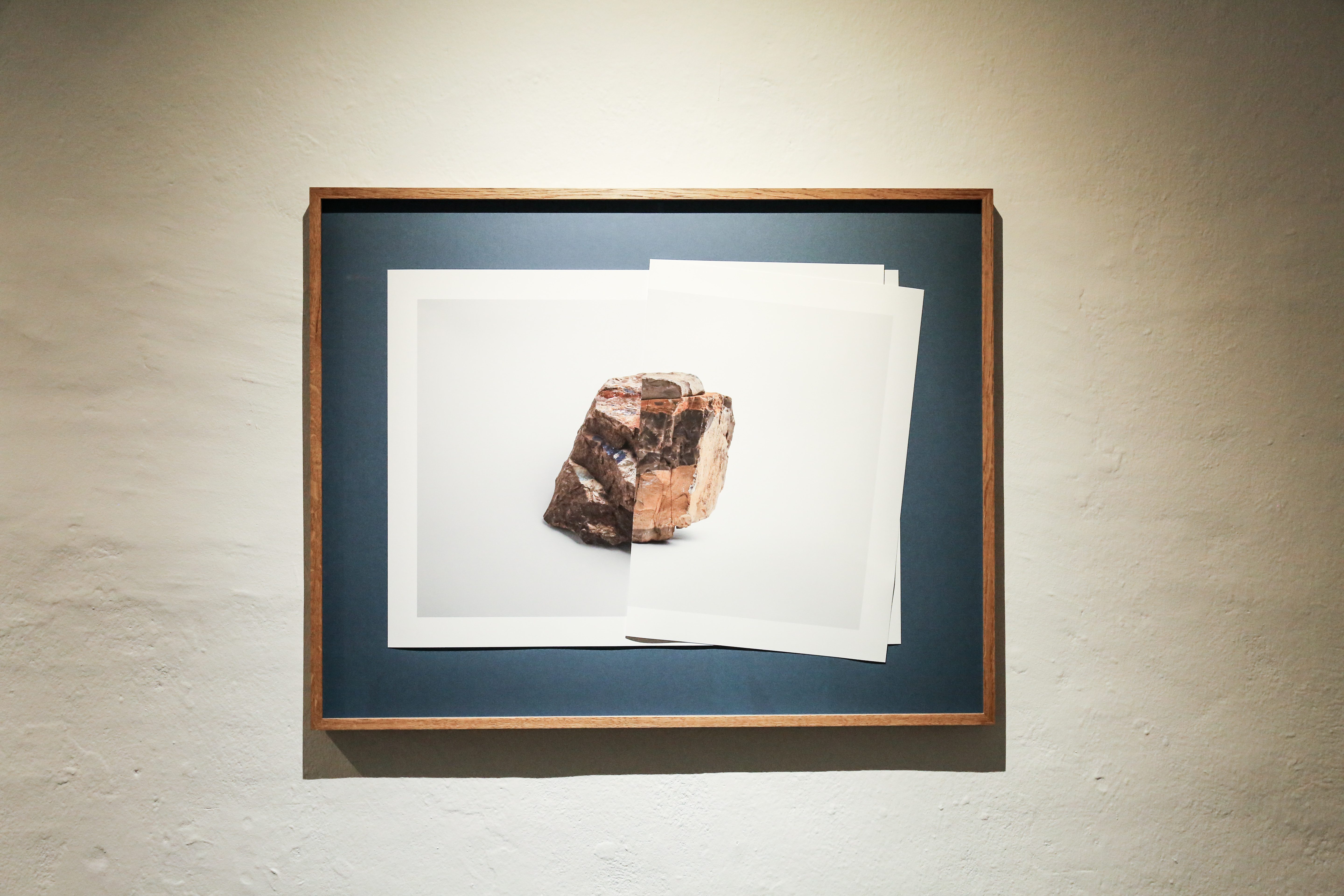
"Subduction Studies"
Kapwani Kiwanga
2015-2017
Photo by Anneli von Klitzing

"Subduction Studies"
Kapwani Kiwanga
2015-2017
Photo by Anneli von Klitzing

"Subduction Studies"
Kapwani Kiwanga
2015-2017
Photo by Anneli von Klitzing

"Subduction Studies"
Kapwani Kiwanga
2015-2017
Photo by Anneli von Klitzing
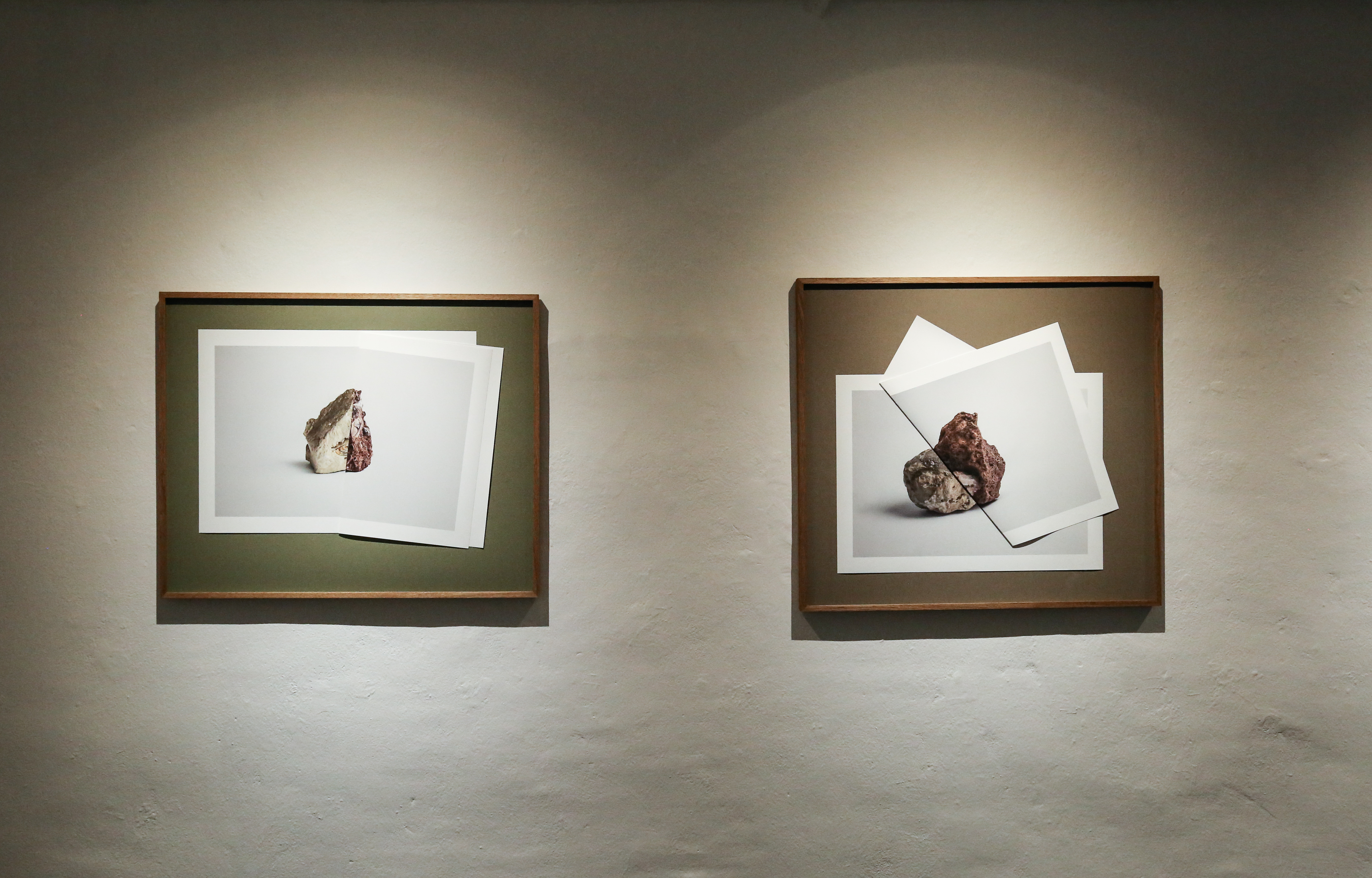
"Subduction Studies"
Kapwani Kiwanga
2015-2017
Photo by Anneli von Klitzing

performance Cloud Chamber by Emilija Škarnulytė
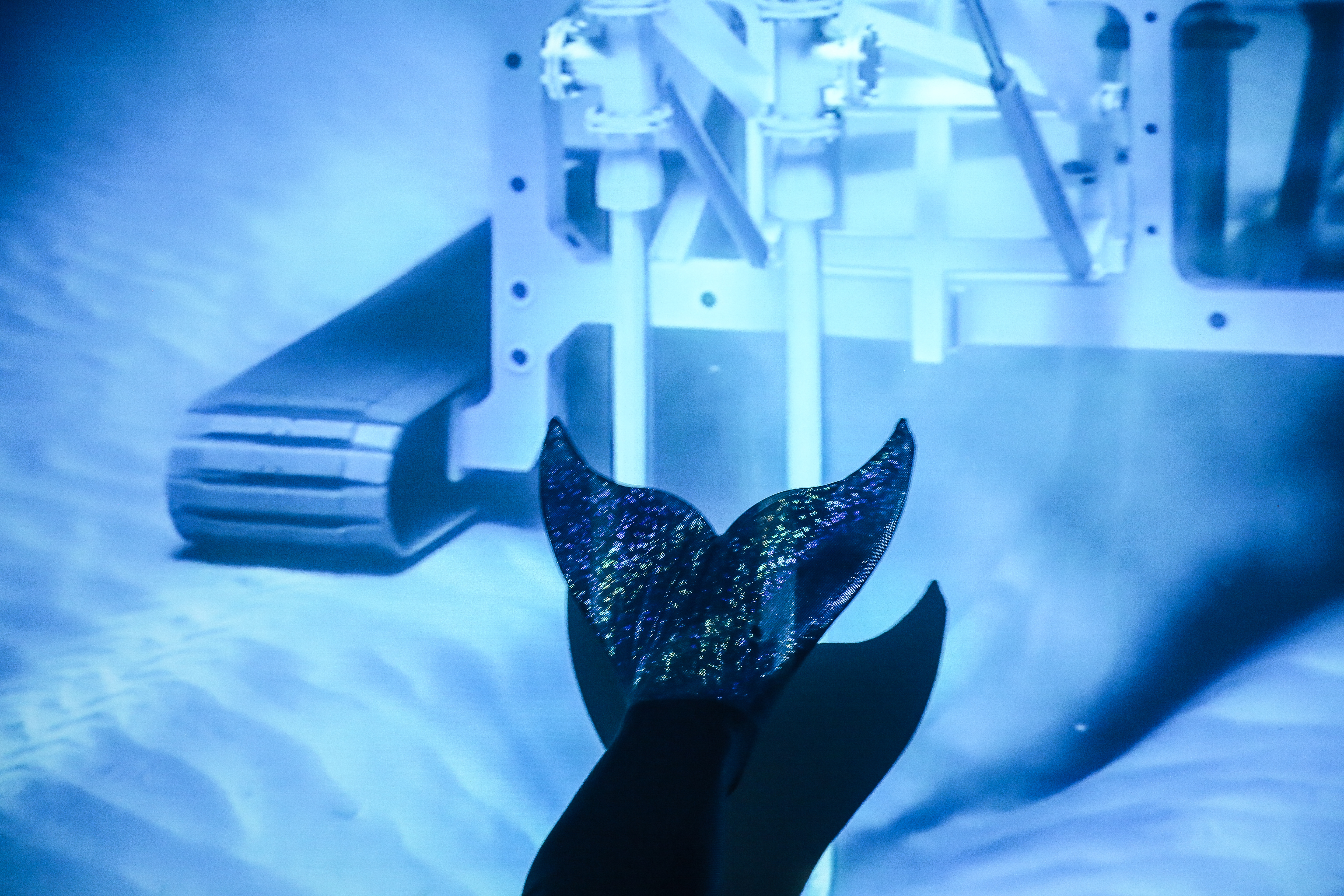
performance Cloud Chamber by Emilija Škarnulytė
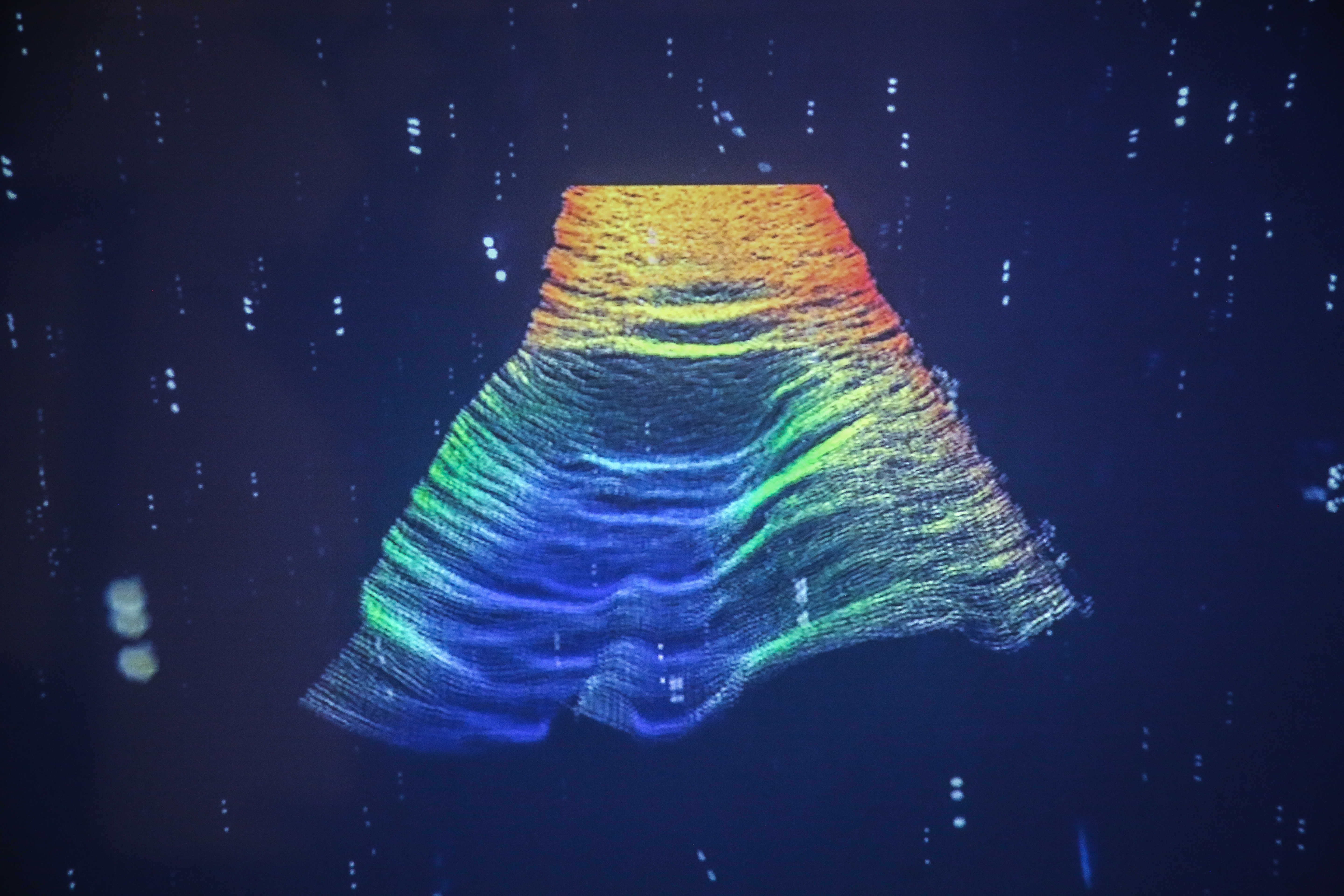
performance Cloud Chamber by Emilija Škarnulytė
The way to handle an immense topic is often through close attention to a small aspect of it, revealing the whole through the part. In the works of Susanne M. Winterling that is exactly what happens. Zooming in on a remarkable species, like bioluminescent marine organisms, printed in 3D, installing them in a sensual way and in such, quasi hypnotizing and making the audience aware of those ‘other ‘ living organisms that are around since way beyond the human timescale and have incredible healing and survival skills we are not aware of.
Looking at time and science fiction, beyond the white, male and heteronormative dominance, is another aspect of Variations on Time. What would the world look like if the white man hadn’t colonized great parts of it; if black people had not been enslaved? Would racism still exist? The legendary American jazz musician Sun Ra, who passed away in 1993, formulated such an alternative reality. He created a mystical tale about his origin in which he claimed that he had arrived on Earth from Saturn. By reimagining reality he could create a narrative that set him free from the history of slavery and its dehumanizing consequences. The film Sun Ra Repatriation Project by the Canadian artist Kapwani Kiwanga follows her attempt to return Sun Ra’s remains to their original home: Saturn.
Working with sound, film, performance, and objects, Kapwani Kiwanga (born in Canada, based in Paris) relies on extensive research to transform raw information into investigations of historical narratives and their impact on political, social, and community formation. Her work focuses on sites specific to Africa and the African diaspora, examining how certain events expand and unfold into popular and folk narratives, and revealing how these stories take shape in objects and oral histories. Trained as an anthropologist, Kiwanga performs this role in her artistic practice, using historical information to construct narratives about groups of people. Kiwanga is not only invested in the past but also the future, creating speculative dossiers from future civilizations to reflect on the impact of historical events.
In the series Subduction Studies (2015-2017), Kiwanga observes the space between Earths continents, specifically Africa and Europe. The speculation of Pangaea Ultima suggests a supercontinent occurring again, which will see Europe slipping underneath Africa. This theory inspired Kiwanga to take photographs at the National Museum of Natural History in Paris of rock specimens from the Northern coast of Africa and Spain. By folding the photographs together, she not only demonstrates a new form but also a new geopolitical perspective, where two continents and their migrants would be geographically connected.
Susanne M. Winterling (born and living in Rehau and Berlin, Germany) works across a range of
media to explore the sentient economy, digital cultures and the social life of materials in the environment. Winterling’s practice reflects upon political as well as aesthetic entanglements and power structures among human/animal/matter.
Forms and materials form a narrative on the relationship between species and elements in today’s challenging geopolitical context. Working across a variety of media and with a constant challenging and questioning of artistic media in society, Winterling is known for her time-based installations that critically engage the representation of reality. Prevailing modernistic concepts, power structures, and hierarchical historiographies are captured and investigated in her work in the form of spatial constellations. Her practice emphasizes what pure information and form leaves out —including a sensual approach to media and material as well as body flows. Winterling undertakes affective and material-based research that highlights the subjective interaction between producers, viewers, materials, and species in our ecology.
Susanne Winterling’s recent research has centered around microscopic and satellite image captured marine organisms called dinoflagellates. These protagonists are bioluminescent: when mechanically activated—by the movement of swimmers or boats—populations of dinoflagellates cause a blue glow in the water. Physicist-cum-philosopher Karen Barad cites dinos as one instance of queer nature: “They are neither plant nor animal, but can act as both.” Winterling calls the bioluminescent dinoflagellates and the ecosystems in which they are embedded an affective, haptic system. The teeny organisms react to touch in a way the artist compares to a living touchscreen. In this work, she deliberately blurs the lines between the human hand, technology, and plankton. The viewer is put at eye level with the suspended and enlarged organism, albeit one that doesn’t have eyes or a central nervous system. While being a perfect example of embodiment the sentient species are an alarm system for changes now heavily announced on the planet. They suggest an alternative way to imagine communication and community, while sentient species that awaken by melting ice have turned toxic and remind us of a future with transformations to come.
In her new video work Epiphyte (to learn from) (2018) Susanne M. Winterling recreated an epiphyte in CGI. This is a kind of organism that grows on the surface of a plant and derives its moisture and nutrients from the air, rain and water (when in marine environments)—or from debris that accumulates around it—many, for example, hang in electrical cables. This work engages with paying attention to, and learning from plants, microbes and mushrooms that have speculative future-solution features in comparison to humans: they create their own energy, or suck water from the sky. Paying attention to these skills and knowledge systems, networking and “being-with“ shows us a different path to the future transformation and adaptation processes happening in reaction to climate change. As part of a tba 21 academy fellowship and the desert lab, Winterling started exploring those living organisms. They are experts at the edge of the desert and allow life to exist in extreme situations for a long time. Her poetic and technological exploration of the epiphytes allows the viewer to imagine future scenarios of co-existence: reflection about cohabitation between species, but also eroding the difference between life and non-life.
The performance Cloud Chamber by Emilija Škarnulytė explores questions of the beginning of the universe in relation to the geological un-grounding processes, invisible structures, geo-traumas and deep time. It is a fictional visual meditation about contemporary science and across sections of the larger systems of power and the politics of desire. The relations between humans and nonhumans become transfigured and weaved equally into the new forms of life.
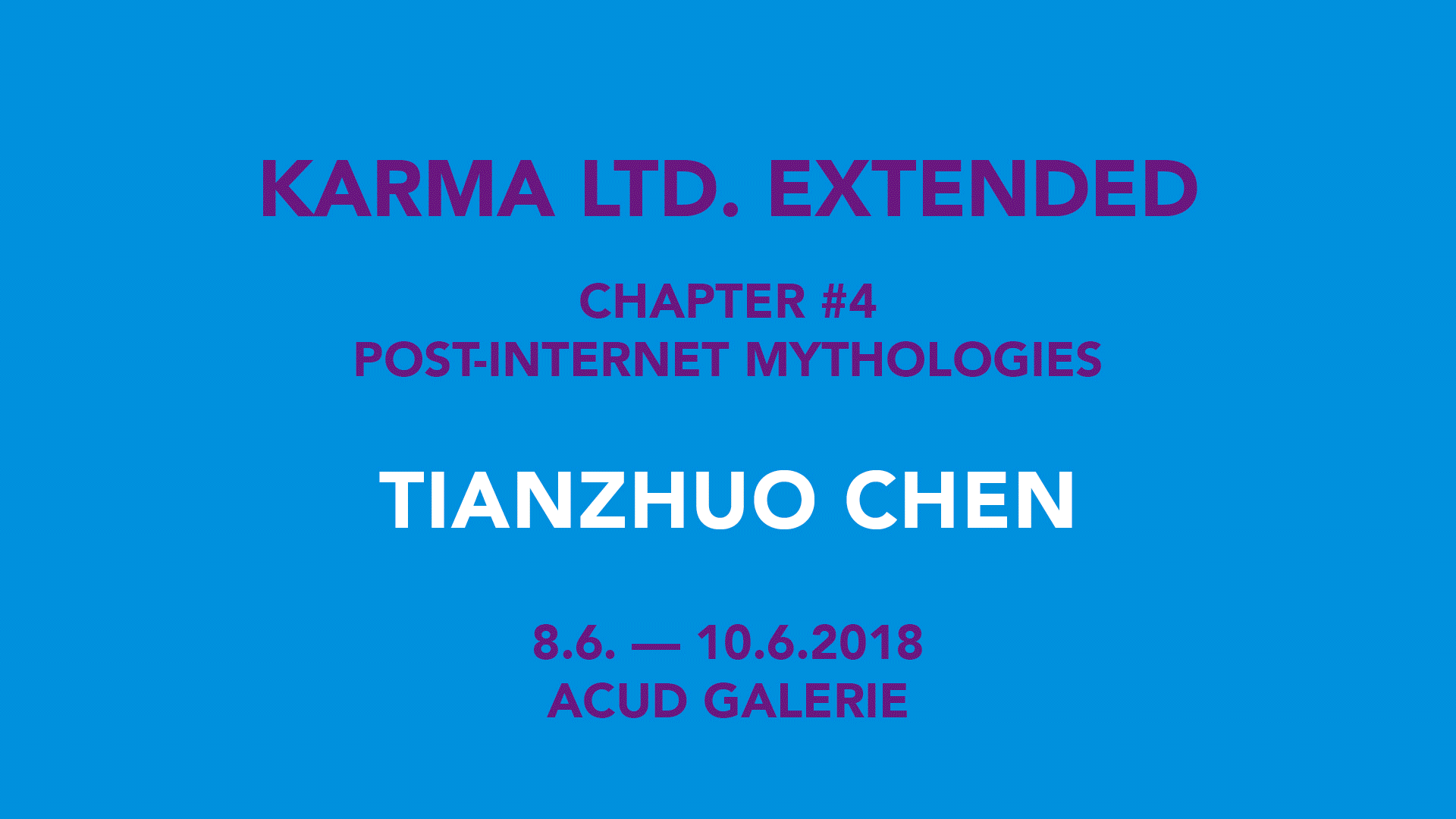
KARMA LTD. EXTENDED
CHAPTER #4: POST-INTERNET MYTHOLOGIES
08.06. – 10.06.2018

Video Installation by Tianzhuo Chen

Video installation by Tianzhuo Chen at Acud Galerie

Live Performance with Beio, China Yu and Felix-Florian Tödtloff

Video Installation and Performance by Tianzhuo Chen

Photo credits: Anneli von Klitzing

Installation by Tianzhuo Chen, Photo credits: Anneli von Klitzing

Live Performance with Beio, China Yu and Felix-Florian Tödtloff

Photo credits: Anneli von Klitzing

Make Up by Servullo Mendez

Live Performance with Beio, China Yu and Felix-Florian Tödtloff, Photo credits: Anneli von Klitzing

Live Performance with Beio, China Yu and Felix-Florian Tödtloff

Photo credits: Anneli von Klitzing

Live Performance with Beio, China Yu and Felix-Florian Tödtloff

Photo credits: Anneli von Klitzing

Photo credits: Anneli von Klitzing

Photo credits: Anneli von Klitzing

Live Performance with Beio, China Yu and Felix-Florian Tödtloff

Photo credits: Anneli von Klitzing
Within the smoke of the fog machines, divine iconography meets throbbing beats. Strobe light encounters naked skin. Buddhist cosmology meets the codes of the global internet culture. The boundary-breaking works likewise reminiscent of drug-fueled reverie in an underground club as it is of a yoga retreat in India’s Varanasi.
The overlapping aesthetics of Tianzhuo Chen’s theatre performances, video installations and sculptures are infused with the iconographic vocabulary of divinities, ceremonies, and rituals of a variety of cultures. Blending, among others, references to Japanese theater and dance forms such as butoh and kabuki, but also to the sounds, symbols, and hedonism of a global youth culture. Tianzhuo Chen creates experiential spaces that are as sensual as they are grotesque. They seem to be free of the social, political, cultural, and religious structures and borders of the era. Stereotypical imagery is taken in hand in order to break it open, dissect it and put it back together. Within this Post Internet intoxication, a campy bricolage reveals a globally inspired self-portrait between commerce, kitsch, spirituality and the apocalypse.
In the course of Chapter #4, Karma Ltd. Extended in cooperation with Torstraßen Festival invited Tianzhuo Chen together with his performers Beio and China Yu to take over ACUD Galerie for three days. Alongside chosen video works on display, Tianzhuo Chen is going to develop a site-specific and newly commissioned durational performance piece.
Tianzhuo Chen lives and works in Beijing and Shanghai. After his studies at the Saint Martins College, he made a name of himself as a visual artist. Alongside the foundation of his Party and Fashion label Asian Dope Boys, his theatre performances also became well known. In Ishvara or An Atypical Brain Damage, which were presented at Wiener Festwochen (Vienna), steirischer herbst (Graz) and Kampnagel (Hamburg) amongst others, he collaborated with musicians such as Aisha Devi, Dis Fig and Kakushin Nishihara. Currently, Tianzhuo Chen is working on a new music clip for Aisha Devi, while An Atypical Brain Damage continues touring.
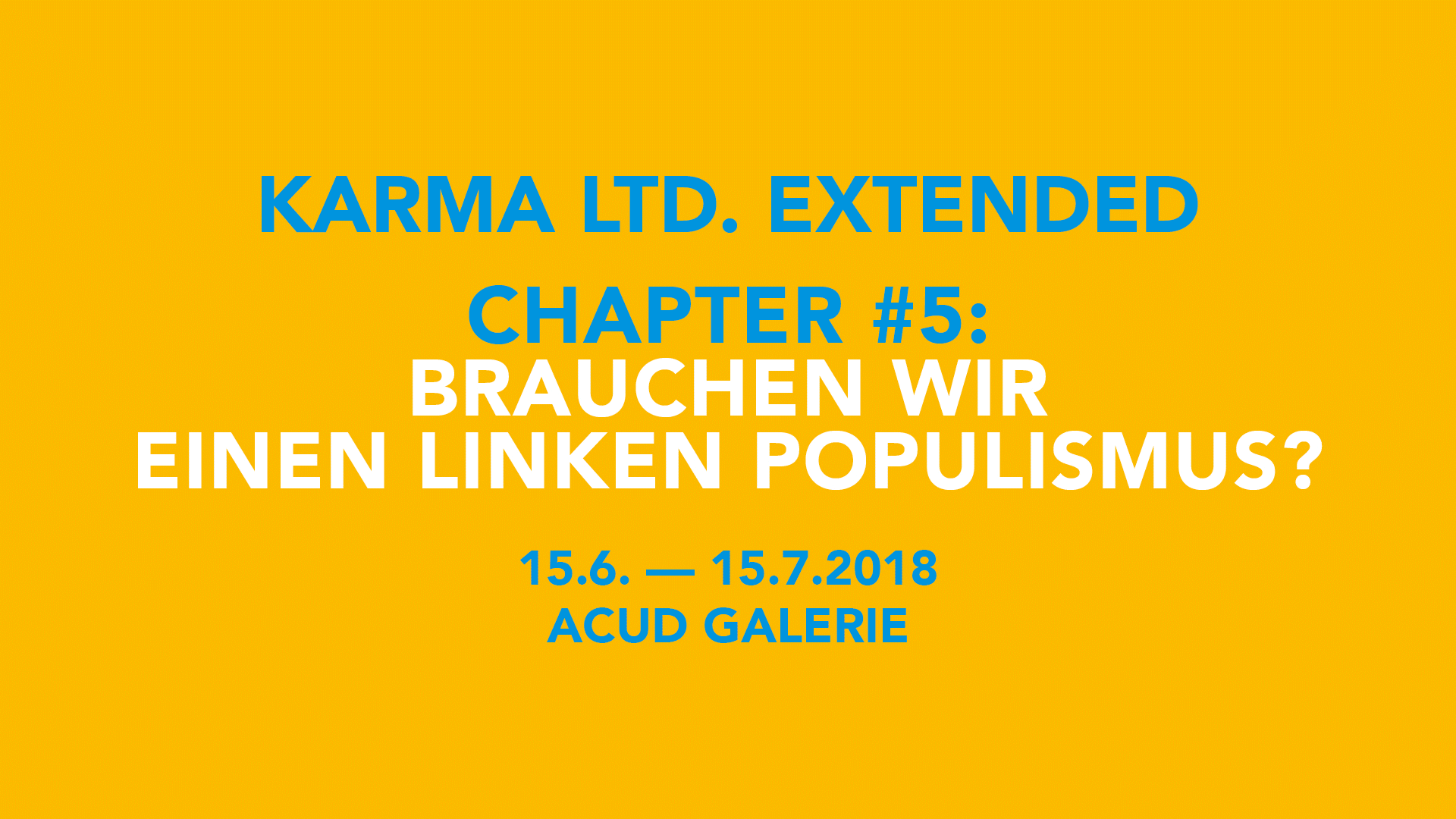
KARMA LTD. EXTENDED
CHAPTER #5: Brauchen Wir Einen Linken Populismus?
15.06. – 15.07.2018

Anne Duk Hee Jordan, Strawberry Canon, All photos courtesy of Pierluigi Muscolino

"Strawberry Canon", 2011
Anne Duk Hee Jordan
Photo by Pierluigi Muscolino

Video "Symbolic Threats" (New York City/Berlin, HD-Video, 17min), 2015
Werkme/Leinkauf
Photo by Pierluigi Muscolino

"Jugenbilder", 2006-2018
Leon Kahane
Photo by Pierluigi Muscolino
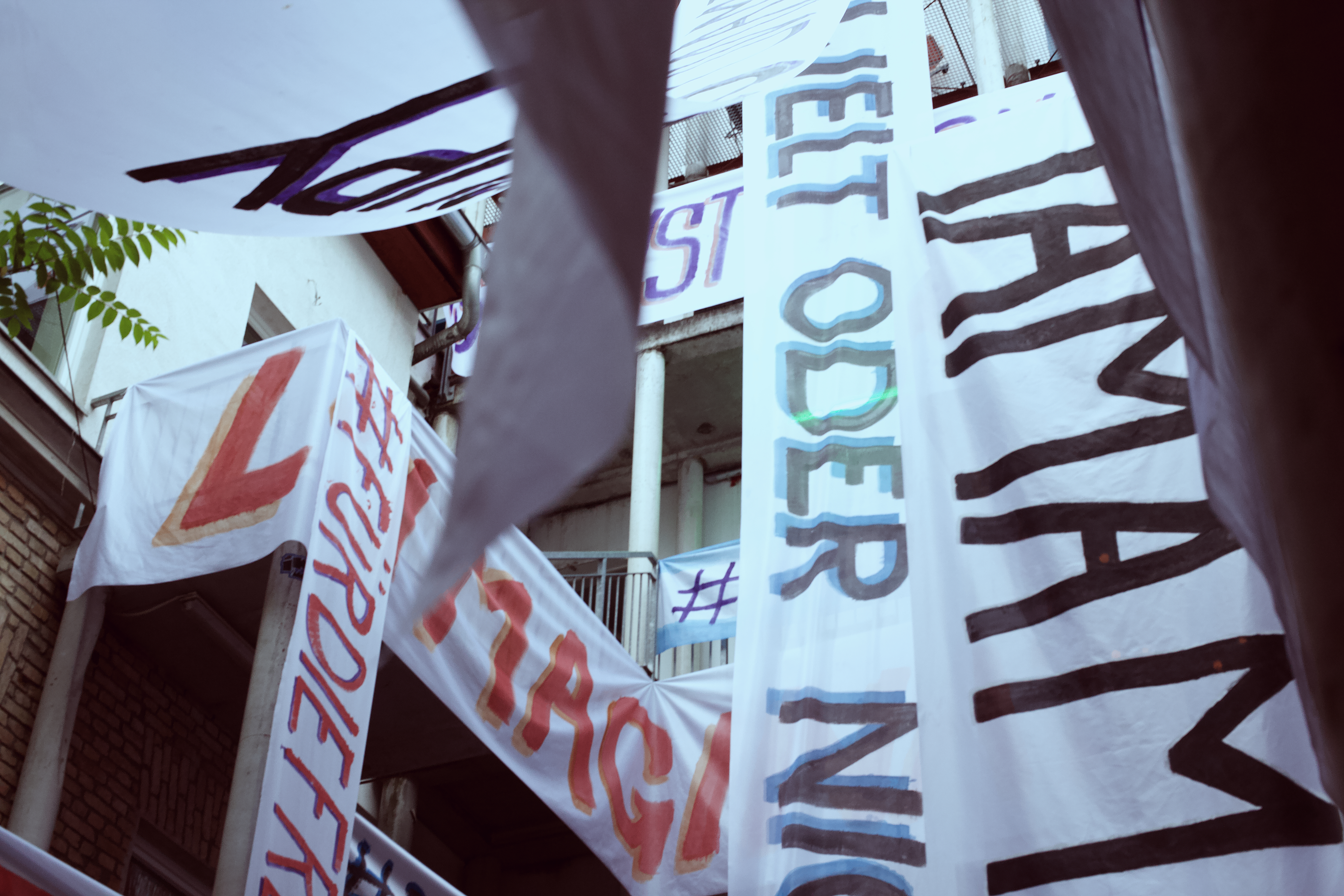
Site-specific installation in Acud's courtyard "Die Imaginäre Bewegung", 2018
Raul Walch, Photo by Pierluigi Muscolino

Talk by Margarita Tsomou

Raul Walch

Anne Duk Hee Jordan, Strawberry Canon, All photos courtesy of Pierluigi Muscolino

Site-specific installation in Acud's courtyard "Die Imaginäre Bewegung", 2018
Raul Walch, Photo by Pierluigi Muscolino
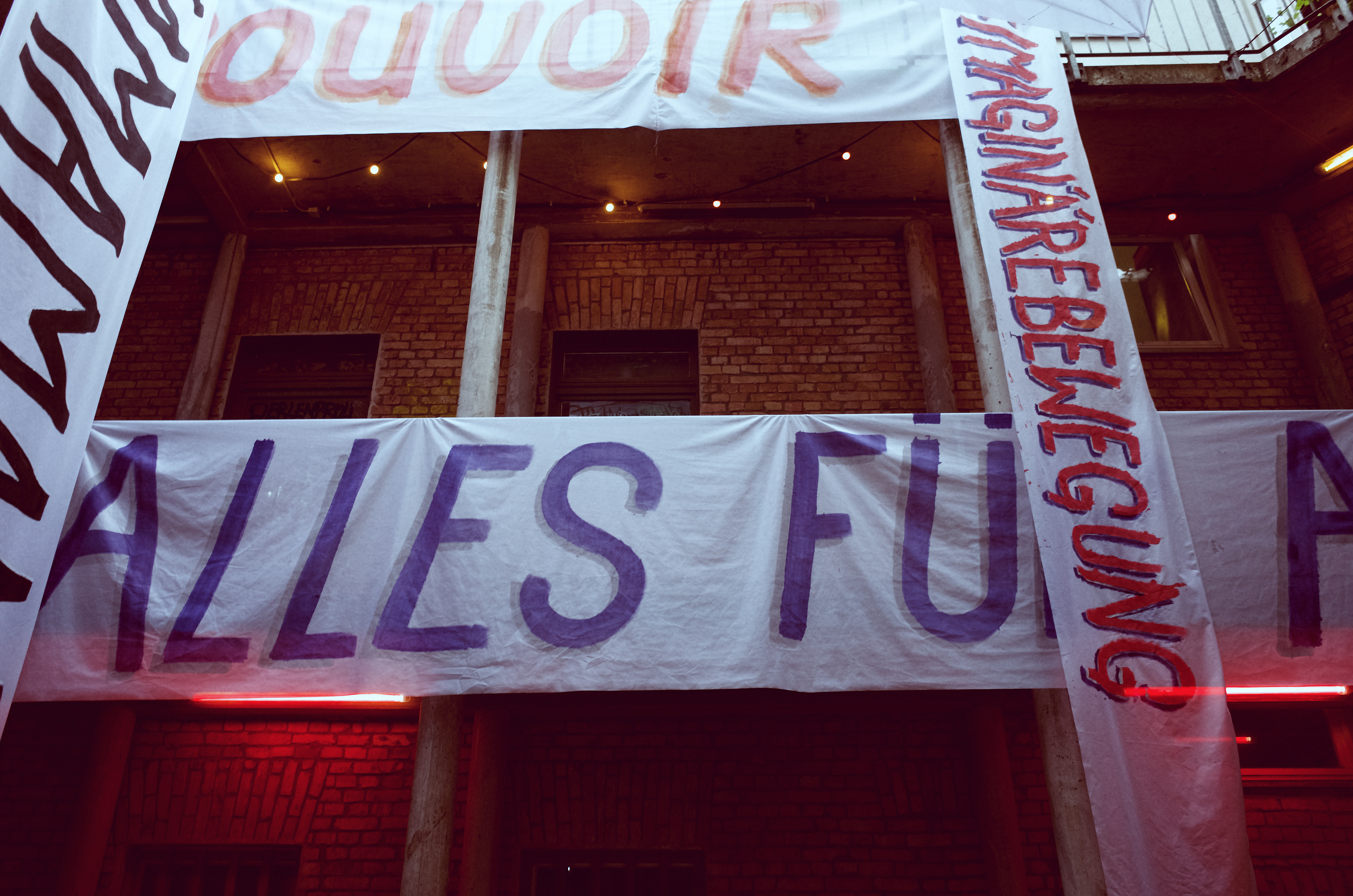
Site-specific installation in Acud's courtyard "Die Imaginäre Bewegung", 2018
Raul Walch, Photo by Pierluigi Muscolino

Site-specific installation in Acud's courtyard "Die Imaginäre Bewegung", 2018
Raul Walch, Photo by Pierluigi Muscolino
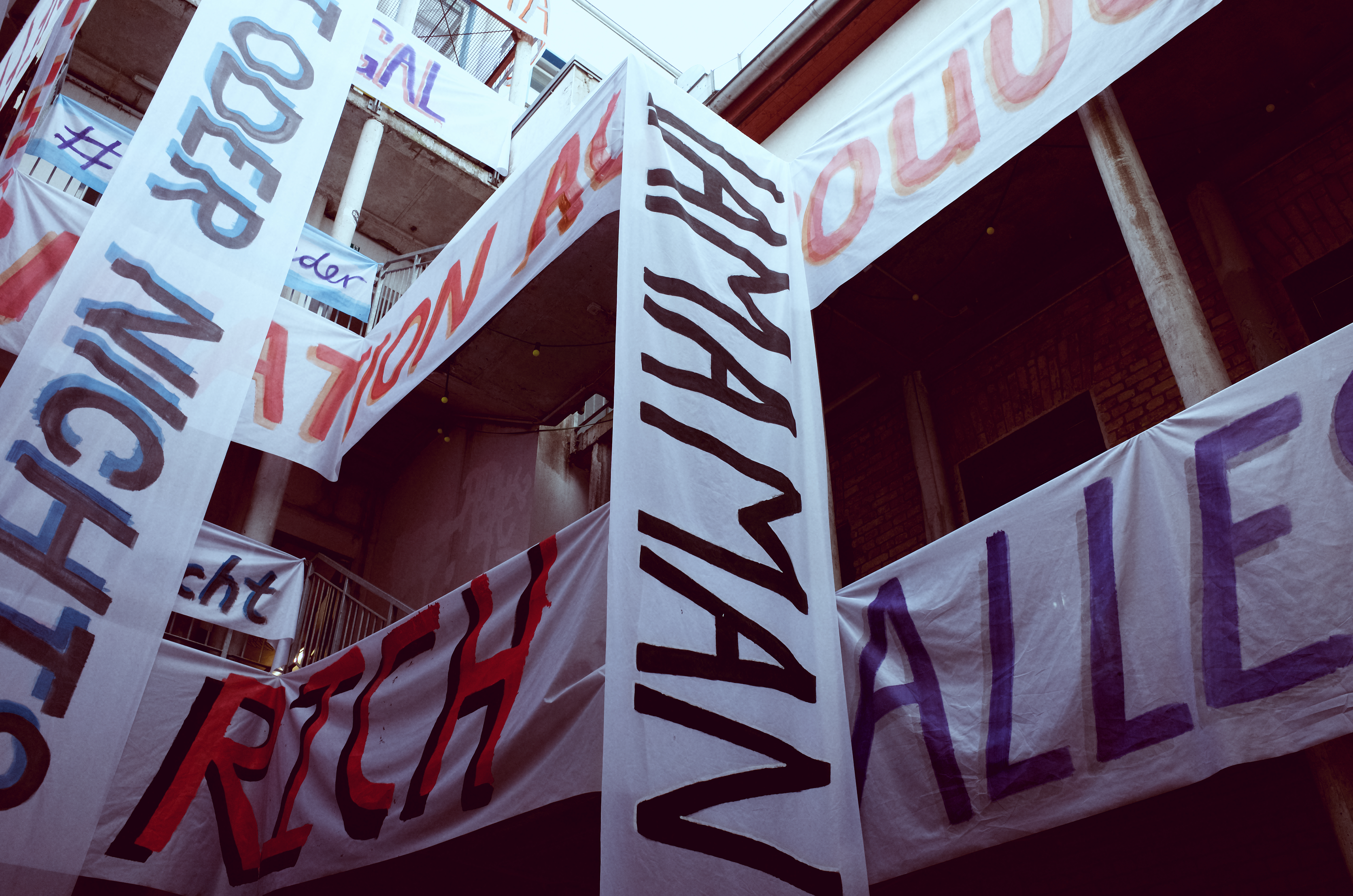
Site-specific installation in Acud's courtyard "Die Imaginäre Bewegung", 2018
Raul Walch, Photo by Pierluigi Muscolino

"Jugenbilder", 2006-2018
Leon Kahane
Photo by Pierluigi Muscolino

"Jugenbilder", 2006-2018
Leon Kahane
Photo by Pierluigi Muscolino

"Jugenbilder", 2006-2018
Leon Kahane
Photo by Pierluigi Muscolino

"Jugenbilder", 2006-2018
Leon Kahane
Photo by Pierluigi Muscolino

"Jugenbilder", 2006-2018
Leon Kahane
Photo by Pierluigi Muscolino

Site-specific installation in Acud's courtyard "Die Imaginäre Bewegung", 2018
Raul Walch, Photo by Pierluigi Muscolino

"Strawberry Canon", 2011
Anne Duk Hee Jordan
Photo by Pierluigi Muscolino

"Strawberry Canon", 2011
Anne Duk Hee Jordan
Photo by Pierluigi Muscolino
KARMA LTD. EXTENDED
CHAPTER #5: DO WE NEED LEFT-WING POPULISM?
15.06.2018 – 15.07.2018
ACUD Galerie & ACUD Courtyard
Artists: Anne Duk Hee Jordan, Leon Kahane, Margarita Tsomou, Raul Walch, Wermke/Leinkauf and
many more.
Curators: Pauline Doutreluingne and Petra Poelzl (Karma Ltd. Extended)
All power comes from the people. But where does it go to?
Bertolt Brecht
In Populism: A Very Short Introduction (Kaltwasser/Mudde, 2017) populism is defined as an ideology that considers society to be separated into two homogenous and antagonistic groups, the pure people and the corrupt elite, and it is argued that politics should be an expression of the general will of the people. Populists claim that they, and they alone, represent the people. The idea of the single, homogeneous, authentic people is a fantasy; as the philosopher Jürgen Habermas once put it, the people can only appear in the plural. It is a dangerous fantasy, because populists not only thrive on conflict and encourage polarization; they also treat their political opponents as enemies of the people and seek to exclude them altogether.
As right-wing populist are on the rise in Europe, the Belgian political scientist Chantal Mouffe claimed in a newspaper interview: We need a left-wing populism! For Mouffe, the challenge of a strengthened Left-Wing Populism consists mainly in the establishment of a collective will and a chain of equivalence between different sectors such as civil rights and feminism: There needs to be a reconstruction of A People. But would Left-Wing Populism be an adequate alternative to the current critical point of the situation in Europe? How can new political alternatives be conceived at a time when the call for backwards politics seems louder than ever? How has Europe become so open to contemporary right-wing populism? And what conclusions from history must be drawn to break up these right/left dichotomies?
The core of right-wing or left-wing politics has hardly ever been agreed upon. The two terms seem to be changing in a particularly confusing way, and in some ways even switching places, says essayist and reporter Sieglinde Geisel. At the time of the French Revolution, the spatial concepts of right and left suddenly became politically charged. In the French National Assembly the case was still clear: on the left sat the revolution, on the right the monarchy. Later, communism was on the left and capitalism on the right. Two hundred years after the birth of Karl Marx, we realize that his terms no longer describe our world: instead of bourgeoisie and proletariat, modern society is divided into the cosmopolitan and the provincial, those who have an open mind, and those who want a closed society. It is no longer ownership that determines the political orientation, but the attitude of mind; it is no longer being that determines consciousness, but the other way round.
Currently we are in the middle of such a role reversal. However, it seems that the two camps not only exchange their content, but also the site. The left is suddenly perceived as state-bearing elite, while the right defines itself as an alternative. The protest against what already exists comes from the right, while the left is forced to defend its values: democracy, pluralism, enlightenment. So here it seems as if the left is the conservative party, while the right is utopian, with the word Heimat as its battle call. So is today’s revolution happening on the right and is the establishment on the left? The confusion of concepts reflects an epochal change that we have barely understood. Digitization, global warming, global money flows, migration—the classical dichotomous right-left thinking does not seem to be able to cope with the phenomena of the 21st century.
The visual and food artist Anne Duk Hee Jordan creates humorous and romantic machines that reflect, enhance or change biological processes and chemical reactions between living organisms and dead materials. Her works references classical myths and poetry. In the gallery she presents her work “Strawberry Canon” (2011). The “Strawberry Cannon” consists of a completely white lacquered bicycle fixed in place and a red painted apparatus with a hose allowing the visitor to shoot strawberries in a libidinally occupied manner by means of a hydraulic pump operated by pedaling. The impact of strawberries thrown out with large power is dampened by white layers of fabric, at the same time the fabric is gradually and discolored in places by the dye of the strawberries.
Gefügt die Hände zusammengeballt
Im Stacheldraht jener Zeit
Im Taumel der Nichtigkeit
fliegen Erdbeerkugeln
in den Schafshimmel
und flach wurde gelacht.
Leon Kahane‘s work reflects historical, political, economic and biographical aspects. Issues such as diaspora, migration and globalization are at the heart of his artistic work. The artist’s current research centers on the Identitäre Bewegung (Identitarian Movement) in Art and Culture and investigates amongst others the stylistic devices this far-right group applies in creating public images. In the course of Chapter #5, Kahane shows a series of photos, which were featured in part in the article “In the streets of Moabit” (2008) in the weekly magazine Stern. “Jugendbilder” (2006-2018) is a reproduction of these photographs and of the article in which the artist takes a retrospective look, elevating the realities of the lives of young immigrants back into the realm of the visible, and picking up the question of their political and social action spaces. In this privileged moment of photography, Kahane is opening up the issue on media reflection: A highly charged topic in times in which social media bubbles are capable of shaping political opinions of the reader- and spectatorship.
In their actions and installations, Wermke / Leinkauf explore the hidden possibilities of the city and explore the boundaries of public space. With the help of artistic strategies, they create irritations and impurities that enable a new view of everyday situations and activate public space as a field of action. By deliberately exceeding existing boundaries and norms, they challenge common behaviors and limitations. In addition to their own bodies, they also use material, the language of forms and the tools of urban spaces, which can be found in their video installations, films, photo and slide work. For this occasion they contribute with the work “Symbolic Threats” (New York City / Berlin, 2015, HD-Video, 17min) in collaboration with Lutz Henk. The project “Symbolic Threats” illuminates disparate conceptualizations of American and German flags and other symbols of national pride, which are reflected in each country’s understanding of “national values” and responses to police violence. Poetry or threat? An act of surrender or perhaps art? Inspired by the heated debate over the two White American Flags that suddenly appeared on the towers of New York City’s iconic Brooklyn Bridge, the film asks what kind of societal scope art has in the present.
The focus of Raul Walch‘s work is an unconventional, artistic examination of social reality. The playful works and actions of Walch are often ephemeral and, above all, site-specific interventions that respond to their environment in the most diverse places of the world: context and daily politics provide the raw material for the social sculptures of Walch. For Chapter#5 he seizes Acud Courtyard with a dense textile installation. “Die Imaginäre Bewegung” (trans.: The Imaginary Movement) is a political interpellation towards spectators in which utopian engaged slogans strike eyes and awaken consciousness. Close to the Situationist International practice theorized by Guy Debord in the 1970’s and his concept of Psychogeography, an unplanned tour through an urban landscape directed entirely by the feelings evoked in the individual by their surroundings. Walch proposes his own interpretation of the dérive (trans.: Drift) through an imaginary wandering inspired by Internet exploration. Through the hashtag figure, he is updating political slogans from the last fifty years through an activist drifting. Newsfeed like stripes are woven into the architecture elements. His installation could be seen as a metaphor of how citizen masses should occupy the political terrain. By extracting parts of the banners from the Acud and bringing them in the public space, the work claims more urgency to the socio-political landscape of Berlin.
#dieweltodernichts #allesfüralle #jetzt #wirsindviele #jedeeinzelnevonuns #keinmenschistillegal #glänzenstattausgrenzen #verbietenverboten #eattherich #austernfüralle #diezukunftwarfrüherauchbesser #fürdiefreiheitfreizusein #legalizeit #imaginärebewegung #imaginarymovement #arbeitenie #alleslassen #niewieder #muff #gleichheit #wirsindalledeutschejuden #berealisticdemandtheimpossible #limaginationaupouvoir #youtoocansteal #hinterdemidoldiebürokratie #ehefüralle #neithergodnormaster #fahnenflucht #dontdemandoccupy #yell #iamaman #reclaimthestreets #imzweifelfürdenzweifel

Photo by Pierluigi Muscolino

Photo by Pierluigi Muscolino

Photo by Pierluigi Muscolino

Frederica Bueti and Elena Agudio, Photo by Pierluigi Muscolino

Photo by Pierluigi Muscolino

Photo by Pierluigi Muscolino

Photo by Pierluigi Muscolino

Photo by Pierluigi Muscolino

Photo by Pierluigi Muscolino

Photo by Pierluigi Muscolino

Photo by Pierluigi Muscolino
SPEAKERS:
Inga Zimprich (Feminist Health Care Research Group Berlin)
Zofia Nierodzinska (Arsenal Municipal Gallery Poznan)
Diana Arce (Black Lives Matter Berlin)
N.N. (Interventionistische Linke)
Federica Bueti (independent writer, art critic and curator)
Kerstin Wollte (Co-founder of the alliance for the Frauen*kampftags-demonstration)
Elena Agudio (artistic co-director Savvy Contemporary)
In the course of an assembly/discussion Margarita Tsomou and Karma Ltd. Extended are aiming to bring together feminist organizations, people interested and involved in feminist topics starting with the question, if a feminist populism is needed? If so, how would it look like and what would it mean?
The #metoo movement brought many voices together but in order to sustain this movement on a societal level, and empower women and trans people of all color, we need to do more. What exactly? How can this be done in Berlin? How can we unite?
Margarita Tsomou is a Greek author, publisher, dramaturge and curator. She has been published in the pop-feminist publication Missy Magazine, and writes for German newspapers and radio. Her most recent project was a series of events in the discursive program of Paul B. Preciado at documenta 14. This year, her dissertation entitled The Representation of the Many will be published. She belongs to the publishing collective b_books and the artistic activist group Schwabinggrad Ballett.
http://reboot.fm/2018/08/19/karma-ltd-5-do-we-need-a-feminist-populism/

Left-Wing Table by Anne Duk Hee Jordan in collaboration with Herbarium Leipzig, photo credit: Anneli von Klitzing

Left-Wing Table by Anne Duk Hee Jordan in collaboration with Herbarium Leipzig, photo credit: Anneli von Klitzing

Left-Wing Table by Anne Duk Hee Jordan in collaboration with Herbarium Leipzig, photo credit: Anneli von Klitzing

Left-Wing Table by Anne Duk Hee Jordan in collaboration with Herbarium Leipzig, photo credit: Anneli von Klitzing
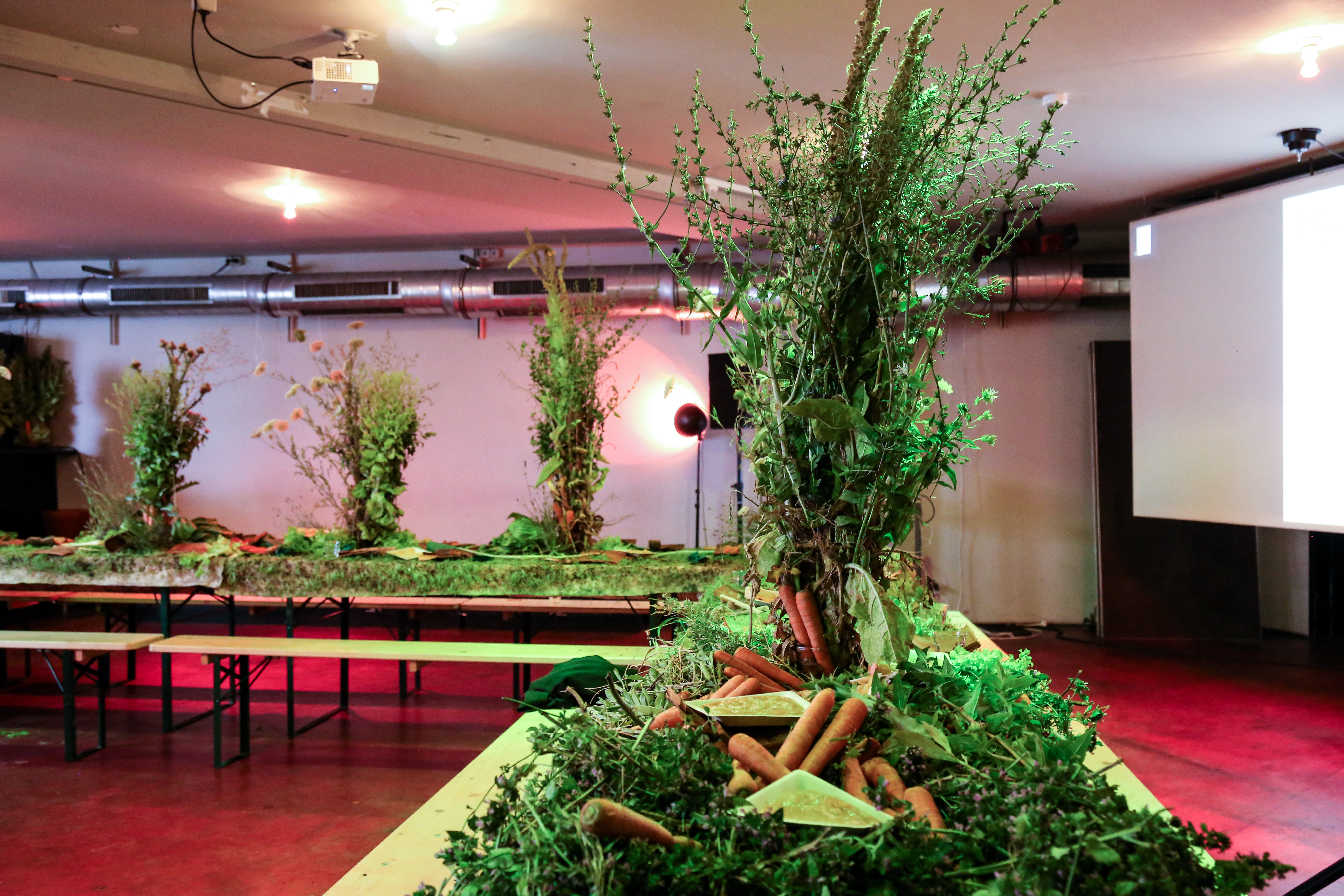
Left-Wing Table by Anne Duk Hee Jordan in collaboration with Herbarium Leipzig, photo credit: Anneli von Klitzing

Left-Wing Table by Anne Duk Hee Jordan in collaboration with Herbarium Leipzig, photo credit: Anneli von Klitzing

Left-Wing Table by Anne Duk Hee Jordan in collaboration with Herbarium Leipzig, photo credit: Anneli von Klitzing

Left-Wing Table by Anne Duk Hee Jordan in collaboration with Herbarium Leipzig, photo credit: Anneli von Klitzing

Left-Wing Table by Anne Duk Hee Jordan in collaboration with Herbarium Leipzig, photo credit: Anneli von Klitzing

Left-Wing Table by Anne Duk Hee Jordan in collaboration with Herbarium Leipzig, photo credit: Anneli von Klitzing

Left-Wing Table by Anne Duk Hee Jordan in collaboration with Herbarium Leipzig, photo credit: Anneli von Klitzing
In collaboration with Herbarium Leipzig, Anne Duk Hee Jordan designs food performances called “Into the Wild”, in which she works with long-forgotten herbs, edible fragrance flowers and tubers. Her last epic performance was the opening dinner of the Riga Biennale 2018 for 200 invited guests on a entirely edible table. Jordan presents an alternative that goes back to the basics of the ecological cycle, in times of climate change and planetary migration. For Karma Ltd Extended, the artist created a Left-Wing Table (Linker Tisch): a social sculpture, open for everyone, where people discussed, envisioned and ate.

CHAPTER #6: SPECIES OF SPACES
22.09 – 28.10.2018
with works by Anna Zett, Heba Y. Amin, Deniz Gül, Lawrence Abu Hamdan
ACUD Galerie
When nothing arrests our gaze, it carries a very long way. But if it meets with nothing, it sees nothing; it sees only what it meets. Space is what arrests our gaze, what our sight stumbles over: the obstacle, bricks, an angle, a vanishing point. Space is when it makes an angle, when it stops, when we have to turn for it to start off again. (Georges Perec, Species of Spaces, p. 80)
SPECIES OF SPACES is the sixth chapter of the curatorial collaboration Karma Ltd Extended. The title of the exhibition refers to the eponymous publication by Georges Perec: Espèces d’espaces (Paris, 1974), in which the writer and filmmaker examines various spatial concepts and questions the definitions of space, border and possibility. Perec’s story tries to remove the reader from his usual views and points of view. What does the dotted line on a map mean? Is it locking anybody in or locking anybody out? Hence, this chapter looks at works of artists that explore political, psychological and sonic interpretations of space. Who is allowed in which territories?
In 2005, the anthropologist and theorist Arjun Appadurai coined the term ethnoscape, this imagined form that hosts people who are travelling, in exile, or on the road. The flow of human beings is an every day occurrence in our world, in which borders are nevertheless becoming harder to cross in ever more bellicose socio-political contexts. Metaphorically, they are doors that prevent – whether by air, by sea or by land – a massive number of people from being able to move freely, from one country to another, from one continent to another, in other words from one space to another. Ethnoscape is one of five elementary frameworks (ethnoscapes, mediascapes, technoscapes, financescapes, and ideoscapes) used by Arjun Appadurai, for the purpose of exploring fundamental discrepancies in global cultural flows. The suffix -scape indicates that these terms are perspectival constructs inflected by the historical, linguistic, and political situatedness of different kinds of actors: nation-states, multinationals, diasporic communities, and subnational groupings and movements, whether religious, political, or economic.
In Chapter #6, Karma Ltd. Extended also looks at the following ambiguity: How can sound alter spatial experiences or be used as a tool for the control of public or private space by authorities? And what if we design spaces and happenings where the subject is the non-human? How can we shake and rethink the obvious, the trivialities of human existence, in a world where consensus sets the tone? The exhibition and the accompanying program of the exhibition SPECIES OF SPACES investigate unusual and unconventional perspectives on subjects, species and spaces.

Installation shot The All-Hearing (2014) by Lawrence Abu Hamdan

The General's Stork (2018) by Heba Y. Amin

The General's Stork (2018) by Heba Y. Amin

The General's Stork (2018) by Heba Y. Amin

The General's Stork (2018) by Heba Y. Amin

The General's Stork (2018) by Heba Y. Amin
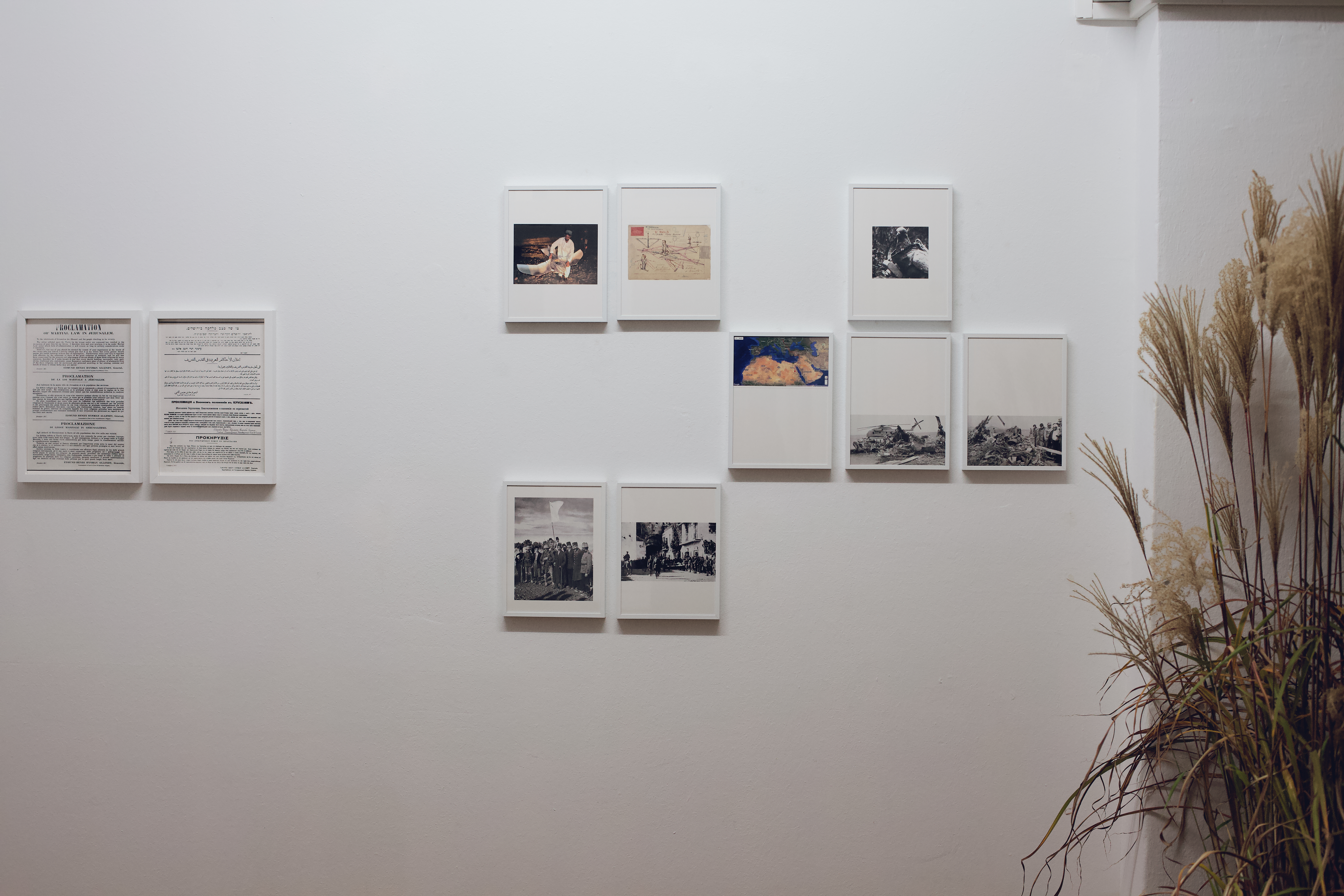
The General's Stork (2018) by Heba Y. Amin

The General's Stork (2018) by Heba Y. Amin

Photo by Pierluigi Muscolino

Spolia, Polka Dots by Deniz Gül

Photo by Pierluigi Muscolino

Photo by Pierluigi Muscolino

Photo by Pierluigi Muscolino

Photo by Pierluigi Muscolino
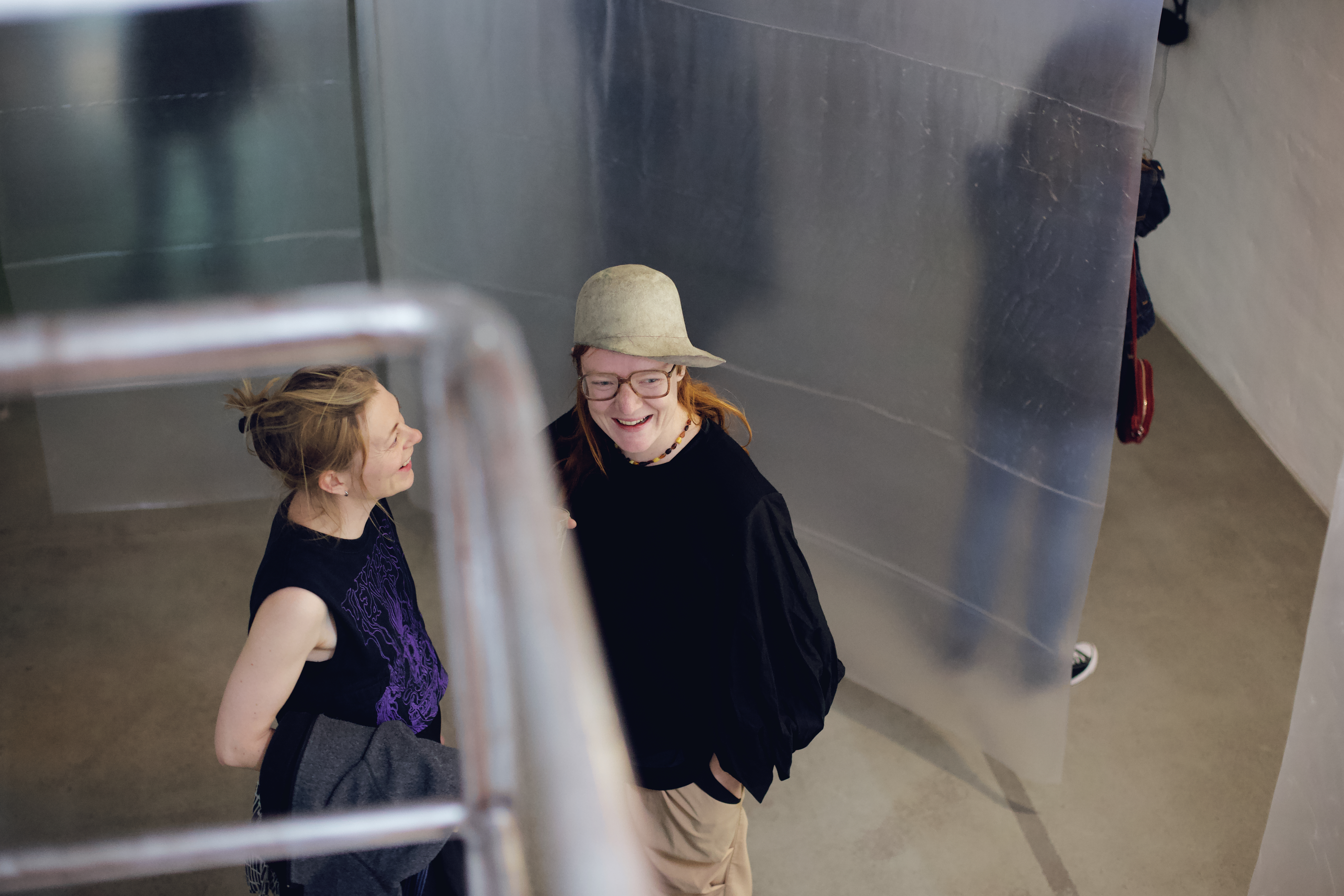
Photo by Pierluigi Muscolino

Photo by Pierluigi Muscolino

Photo by Pierluigi Muscolino

Photo by Pierluigi Muscolino

Photo by Pierluigi Muscolino
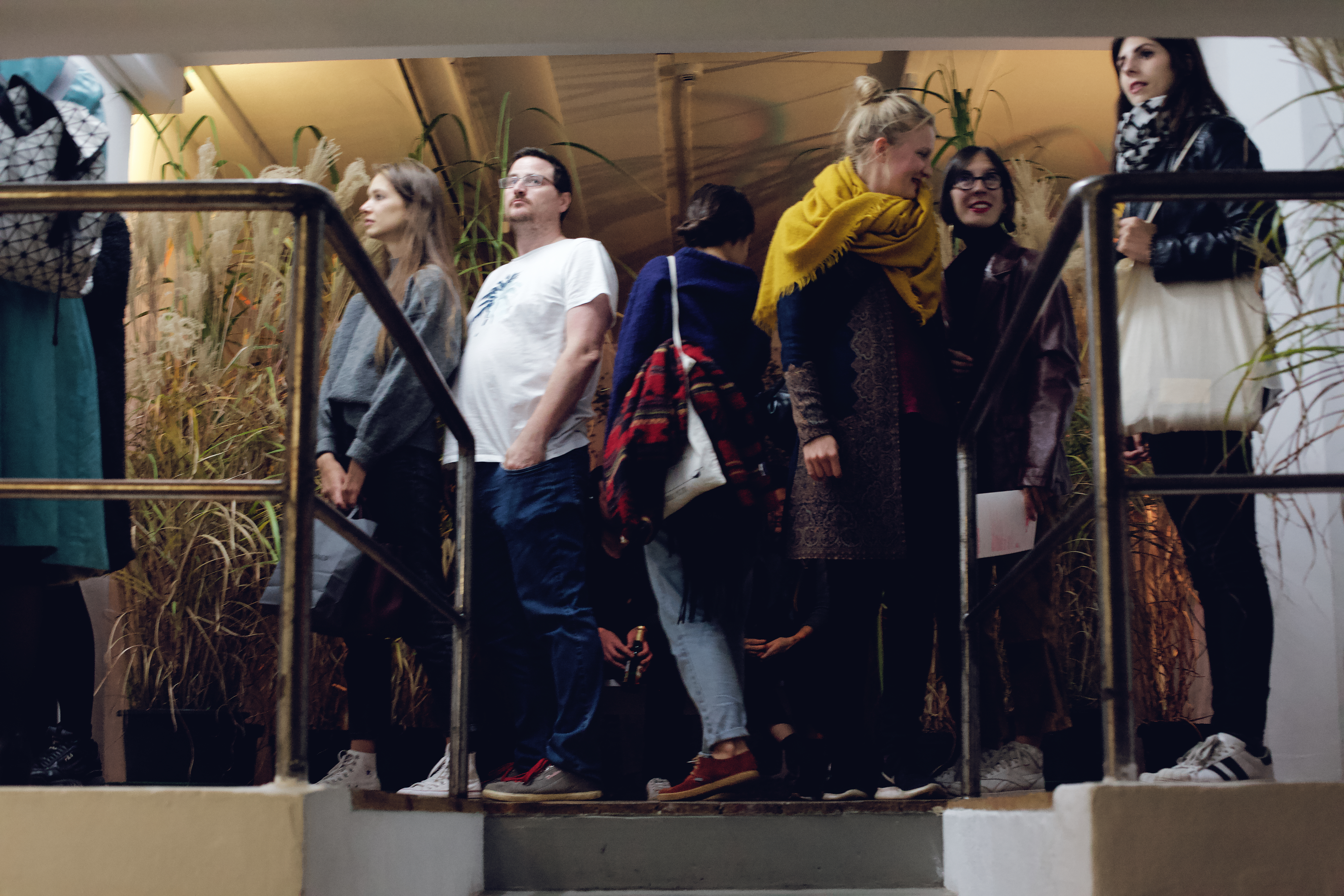
Photo by Pierluigi Muscolino

Photo by Pierluigi Muscolino

Photo by Pierluigi Muscolino
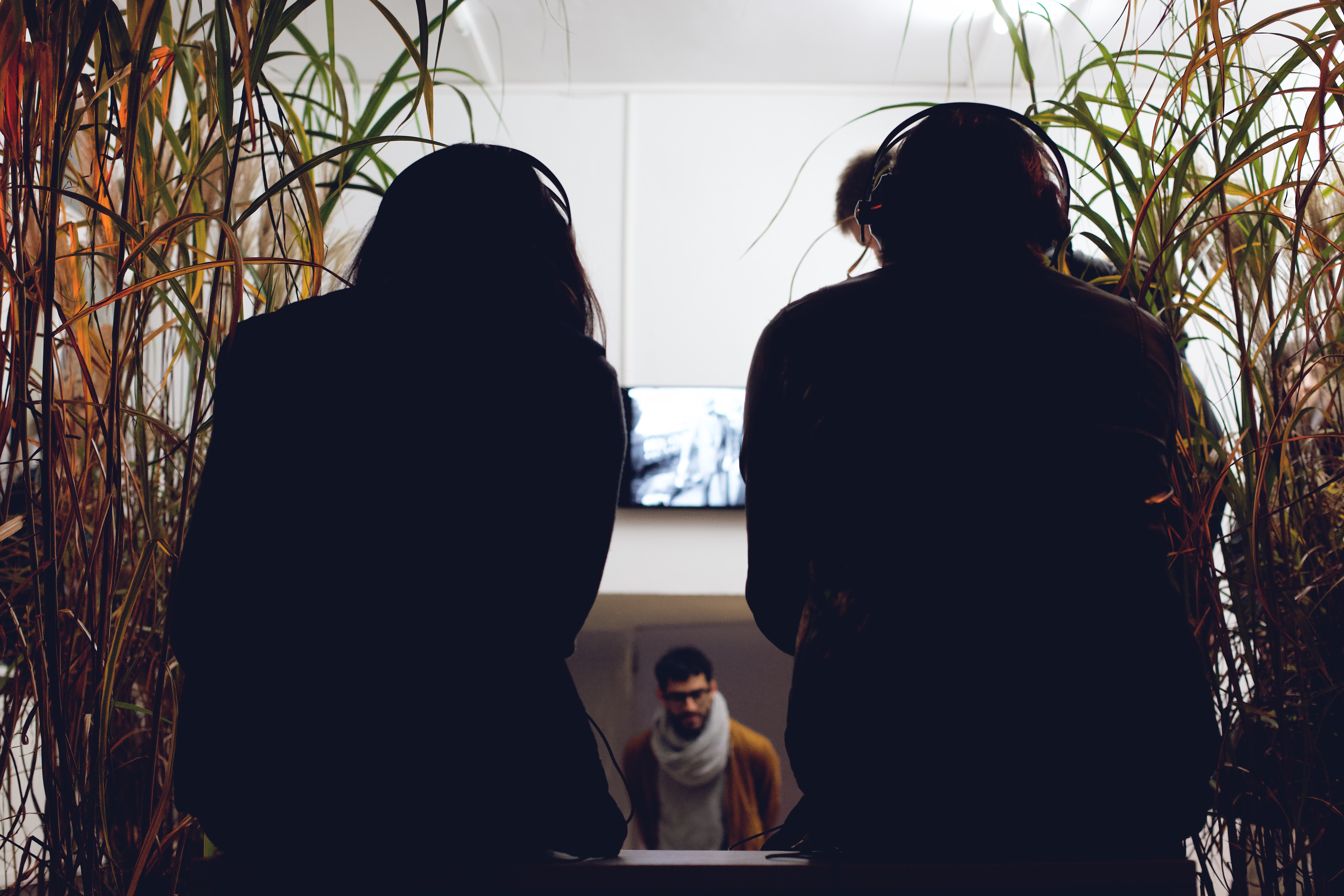
Photo by Pierluigi Muscolino

Photo by Pierluigi Muscolino

Photo by Pierluigi Muscolino

Photo by Pierluigi Muscolino

Photo by Pierluigi Muscolino

This Handy Object by Anna Zett,
Interactive video installation, 2018
2’00’’ and 21’59’’

This Handy Object by Anna Zett,
Interactive video installation, 2018
2’00’’ and 21’59’’

Photo by Pierluigi Muscolino

Photo by Pierluigi Muscolino
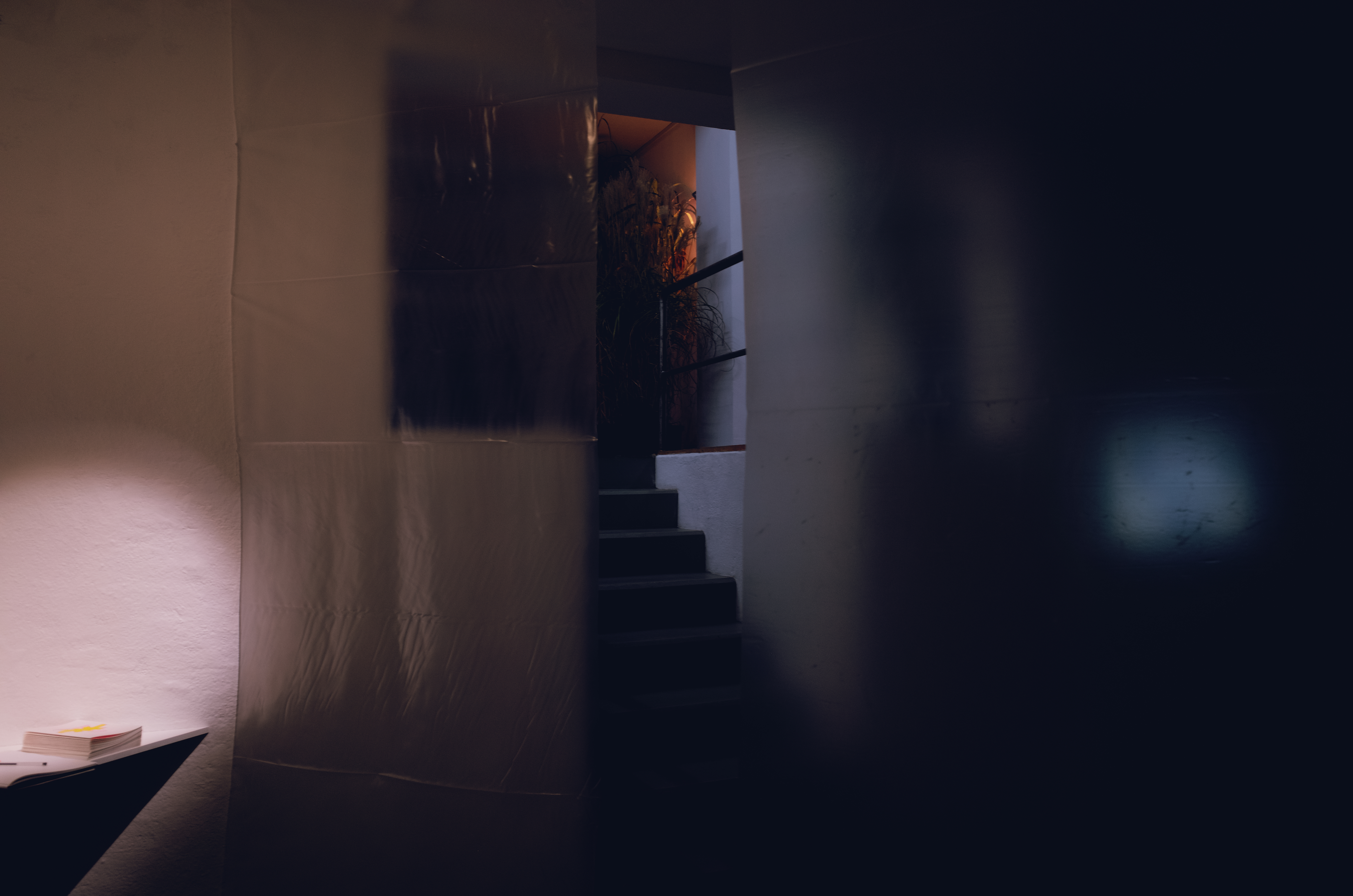
Photo by Pierluigi Muscolino

Spolia, Polka Dots (2018, video) by Deniz Gül

Spolia, Polka Dots (2018, video) by Deniz Gül

Photo by Pierluigi Muscolino

Photo by Pierluigi Muscolino
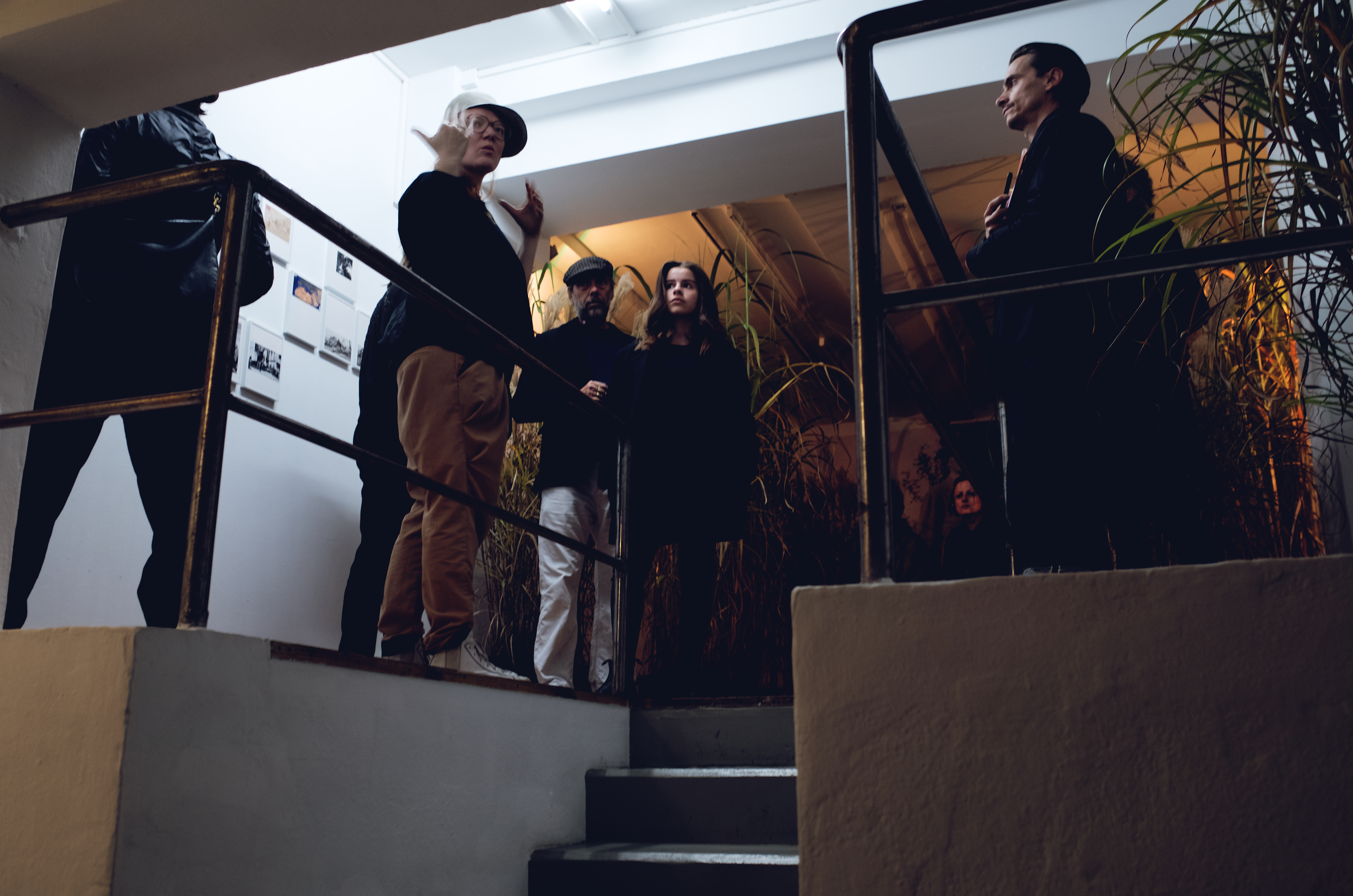
Photo by Pierluigi Muscolino

This Handy Object by Anna Zett,
Interactive video installation, 2018
2’00’’ and 21’59’’

Photo by Pierluigi Muscolino

Photo by Pierluigi Muscolino
Heba Y. Amin (b. 1980, Cairo, Egypt, lives and works in Berlin) is a visual artist, researcher and educator. She examines the influence of infrastructures on the human psyche in many different media using various connecting lines, disturbances and faulty memory cultures. By connecting different stories, she questions and reconfigures narratives from global zones of conflict. She is particularly interested in subversion techniques and critical spatial tactics that challenge existing systems, power relations and powers of interpretation.
The General’s Stork (2016-ongoing, multimedia installation with wallpaper, plants and sound) is inspired by military technologies in the twentieth and twenty-first centuries, when they were developed against the backdrop of Middle Eastern geographies. As war became dictated by the needs of technology, conquest from the sky transformed Western warfare into an imbalanced spectacle of high-tech weaponry. Techno-aesthetics became inherently tied to the image of the Middle East as the language of occupation and colonization was written into the visualization of landscape through land surveying, aerial mapping, bombing and drone warfare.
In 2013, Egyptian authorities detained a migratory stork traveling from Hungary through Israel into Egypt because an electronic device attached to its back led them to suspect it was being used for espionage. Almost one hundred years earlier Lord Allenby, the British High Commissioner in Cairo, appeared to fulfil a biblical prophecy when he launched bird-like machines to capture Jerusalem from the Ottomans. The General’s Stork questions the contemporary condition of our paranoia that leads us to fear attacks from the skies and, in turn, suspect a migratory bird of being an international spy. The installation elaborates on the allegorical film As Birds Flying from 2016.
Deniz Gül‘s (b.1982 in Izmir, Turkey, lives and works in Istanbul) poetic and experimental artistic practice navigates between the fine arts and literature. She is particularly interested in the embodiment strategies of objects and spaces. She meticulously analyses the relationships and contradictions between centre and periphery, body and identity, history and memory, language and archetype, ritual and metaphor. Gül opens spaces that do not seem primarily logical, but rather aim to open up hidden possibilities and perspectives.
In Spolia, Polka Dots (2018, HD video, 5min), a white-collar man walks towards a column in a construction site. Facing the column, the man tries hard to move it. The pillar is unshakable. The man gives up, sits down and starts painting red polka dots on his shirt with nail polish – in a reference to Yayoi Kusama’s infinite dot spaces. When he is finished, he takes off his shirt and we see that the dots have penetrated the shirt and now color his skin. The work refers to the Pillars of Hercules, a myth that speaks of Hercules’ vision of a civilization beyond the outer limits of the known world. According to the myth, Hercules pushed and split the mountain range that joined the continents of Africa and Europe and opened the Mediterranean to the Atlantic Ocean. This opening became a portal, a new reality, for mankind. The so-called Spolia is also the concept of a deconstructed and displaced column, which then is repurposed in new monuments or walls. These architectural fragments from antiquity are frequently found embedded in structures built centuries or millennia later, which of course is a forgotten tradition in today’s concrete landscape. As our 21st century white-collar man tries to push the boundaries of concrete further and further, he realizes he has in fact been engendered by concrete. He, the master, finally himself becomes a tribute to the loss and mourning of spaces inside and out. He is not a demi-god like Hercules, nor he can repurpose the idea of civilization and become a part of a further tradition. He is stuck in this mentally constructed space.
The starting point of Lawrence Abu Hamdan‘s (b. 1985 in Amman, Jordan, lives and work in Beirut) audio-visual installations and performances is his exploration of our auditory consciousness and memory, mostly using the example of highly political contexts. In recent years, Abu Hamdan has often worked as a sound expert with the independent Forensic Architecture Institute, which uses artistic methods to uncover human rights violations, publish evidence and make it available for trial. In his own artistic work, Abu Hamdan develops abstract scenarios that address state and industrial violence and propaganda.
The All-Hearing (2014, HD video, 13min) is concerned with noise pollution and freedom of speech in Cairo, a city where average noise levels sit at a deafening 85 decibels. It addresses the ways in which new laws in the city, ostensibly made to curb noise pollution, have ‘[enforced] Sheikhs to only give speeches according to the weekly government-sanctioned topic’. Following an invitation from Abu Hamdan, two Sheikhs defiantly deliver sermons on a non-sanctioned topic: the ethics of the sonic environment of the city. In this work, the artist inspects the shift from public space to private property domain. The origin of the remarks made by the sheiks, their truth content and the recipients of that content show how freedom of expression is subjected to an authoritarian regime, which insidiously, under the pretext of defending an absolute truth, tries to filter and reduce the noise pollution. The contamination of the urban environment by noise is symptomatic of a society in which, they chide, “we seem unable to control our voices, to say anything but empty words.” The determination of every individual to be heard makes it impossible to separate sense from nonsense, to parse meaning from sound. The irony of the Sheikhs’ use of loudspeakers to broadcast their counsels against noise is reinforced by several cuts to a song blasting out a paean to peace and quiet. That ambiguity extends to Abu Hamdan’s invitation to two religious leaders to pass judgement on who, and what, is fit to be spoken and heard – what constitutes ‘good’ sound.
Anna Zett (b. 1983 in Leipzig, lives and works in Berlin) is an artist, author and director for film and radio. Her work combines documentary research and analytical perspectives with an often playful, interaction-oriented approach. The mythology of modernism between history and practice, between science and fiction, through which Zett investigates the transformation of her political and emotional fields of association, is at the centre of her work. In 2014 she released her first longer video works, both dealing with the dinosaur as a symbolic animal of the US colonial history. Recently she created two experimental radio plays for public broadcasting and a temporary focus shift to more situational formats between choreography and narration.
For this exhibition Anna Zett created a new work entitled This Handy Object (video installation, 2018). The video installation examines the action of understanding from a motor, sensory perspective. A handmade object made of glass serves as a switching point between the body of the viewer and the screen, also made of glass and leaned pragmatically against the wall like a crude mirror. The title is based on Zett’s essay film This Unwieldy Object (2014), a ‘modernist research drama’ and road movie about dinosaurs, the Berlin Wall, historical fictions, projections and dumb rocks at the American Frontier. In This Handy Object, handiness and presence, rather than bulkiness and imagination, now form the entrance to the spatial discussion.

















